
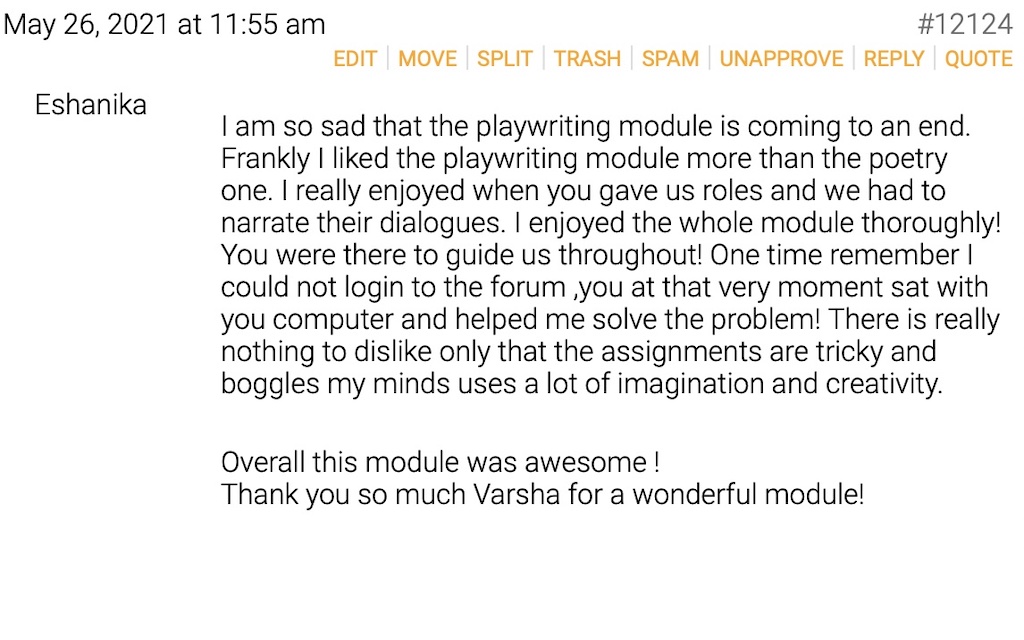
July 18, 2021
“Ooh! I see something suspicious!” one child cried out, holding up her copy of The Monster Hunters. “Look! A monster at the window! Page 2!”
“On page 33 of Bookasura, Bakasura is so big. How did he become so small on page 39?”
“I don’t think Mr Hoppy should have lied to Mrs Silver about Alfie. How can you make friends based on lies?” This from a seven-year-old reading Esio Trot.
“This is so funny; I want to read the next book about Zain & Ana,” says one child.
“I didn’t like the book,” says another. “They say dogs are a nuisance and they call the dog Buddhu! That’s not nice.”
What fun I had at both batches of the June edition of my reading programme! Take a look at what all we did.

From the very first reading programme onwards, I’ve begun each edition with a hOle book. This time, it was The Monster Hunters. What fun we had spotting monsters right through the book! I think that was the highlight of our sessions together. We did a fun activity imagining things under our beds – I see a monster’s eye! What could it be? Ah, it’s just an old torch. This book was a treat!
Among the most exciting activities we did with Bookasura was growing something of our own. At Navaneeth Uncle’s farm, Bala discovers fruit trees; he digs a compost pit and fills it with kitchen waste, and he cleans the fish pond. What can we, in our urban setups grow? I grew mustard (picture below!). Some of the children grew moong, corn, oregano … Oh, and of course it helps that one of the children logged in from a cardamom plantation in Idukki! He had firsthand experience of a kind that none of us do!
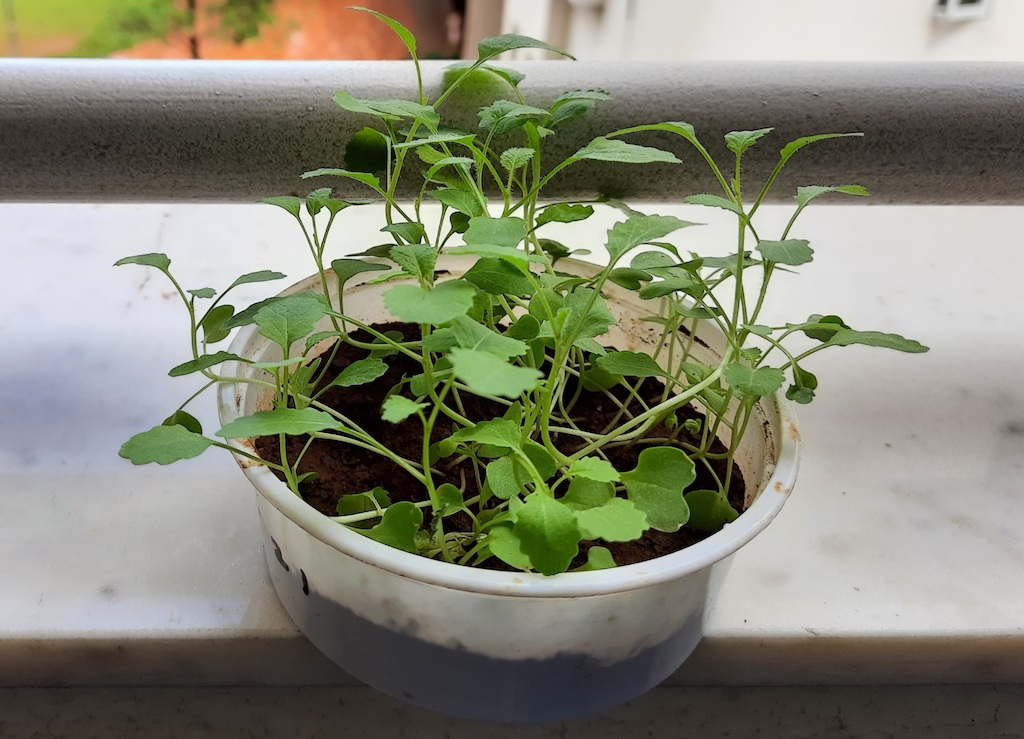
Speaking backwards is almost like speaking in code. Mrs Silver makes it even more fun by calling her backwards chant magic words. What magic can you do by saying things backwards?
emoceb elbisivni!
nrut otni a taog!
raeppasid!
There was so much that I wanted to do with At Least a Fish, but the reading itself took longer than I anticipated because of the number of discussions we had about fish, dogs and dragons! But page 8 of the book is just too much fun to ignore. We laughed, yes, but I was also astounded at how much children know about all kinds of animals! We discussed differences between an elephant and a duck, an octopus and a rat, and a lion and a platypus. We then looked at similarities and that was fun too! How are a hedgehog and a monkey similar? What about a seahorse and a dog?
REGISTRATIONS ARE NOW CLOSED FOR ALL MY READING PROGRAMMES.
The next batches begin in the first week of October. If you would like to receive an email notification when I open for registrations, please fill this form. Alternatively, follow me on social media – Facebook, Instagram and Twitter – for regular updates.
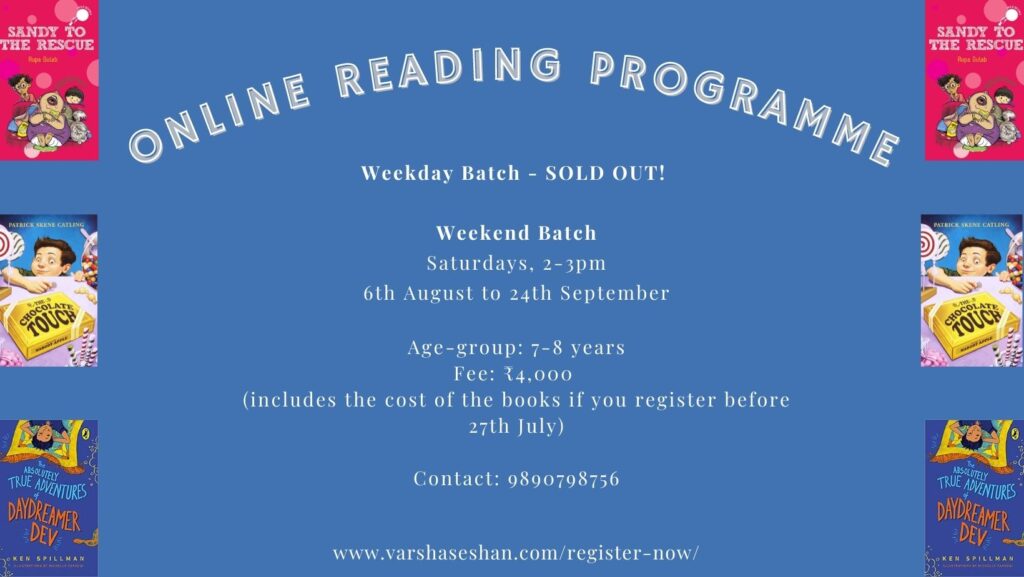
July 14, 2021
Karma Meets a Zombie is probably the most ambitious book I’ve chosen for my reading programme for ages nine and ten. I read Karma Fights a Monster some time ago and I loved it. I even wrote about it in an essay on monsters and stereotypes because I was struck by how unusual the monster is.
Karma Meets a Zombie is a different kind of unusual. For instance, is the monster necessarily the antagonist? What makes someone a monster? And what does a monster hunter do, really?
There are several reasons I call it an ambitious read for my book club. For one, no pictures! It’s the first book we’re reading together that has no inside illustrations.
Two, I haven’t touched upon horror as a theme at all so far, especially as I didn’t read much horror as a child. (I did read a few Goosebumps because I won five of those for … something. Now that I come to think of it, I have no idea what I won. I just remember winning five of the Goosebumps series and five of the Babysitters Club series.)
How will a nine-year-old respond to a hand detaching itself from a zombie and attacking? Honestly, I don’t know. But I find myself thinking – if children can read books like The Witches, why not?
After going back and forth multiple times, I went ahead with this book because it has so much to offer at a programme like mine. Take a look at what I want to do with it.
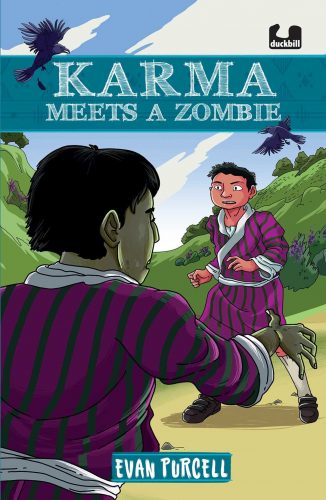
Tenzin used to be the school bully. When he returns to school as a zombie, he becomes the victim, leaving Karma conflicted. Is the monster really the bad guy?
A book like Karma Meets a Zombie opens up several discussions on heroes, villains and all the grey areas in between. I’m sure the discussion will be rewarding!
Working with multiple genres is always fun. Karma Tandin is a delightful narrator – funny, snarky and often confused. This makes Karma Meets a Zombie the perfect story to discuss ideas like comic relief, building suspense and story structure. What standard non-human characters do we use? And how can we add a tiny twist to a standard character (like a vampire) to create surprise and humour?
I was associated with the British Council’s reading challenge for several years, and Creepy House was one of the most popular themes amongst the participants. There’s something thrilling about being slightly afraid. From picture books like Book of Bhoots to middle-grade ones like A Place Called Perfect, children love to explore the darkness in tiny and not-so-tiny ways.
So, how do we write horror? I have a wonderful set of activities on writing stories full of suspense and I can’t wait to use them!
REGISTRATIONS ARE NOW CLOSED FOR THIS READING PROGRAMME.
The next batch begins in the first week of October. If you would like to receive an email notification when I open for registrations, please fill this form. Alternatively, follow me on social media – Facebook, Instagram and Twitter – for regular updates.
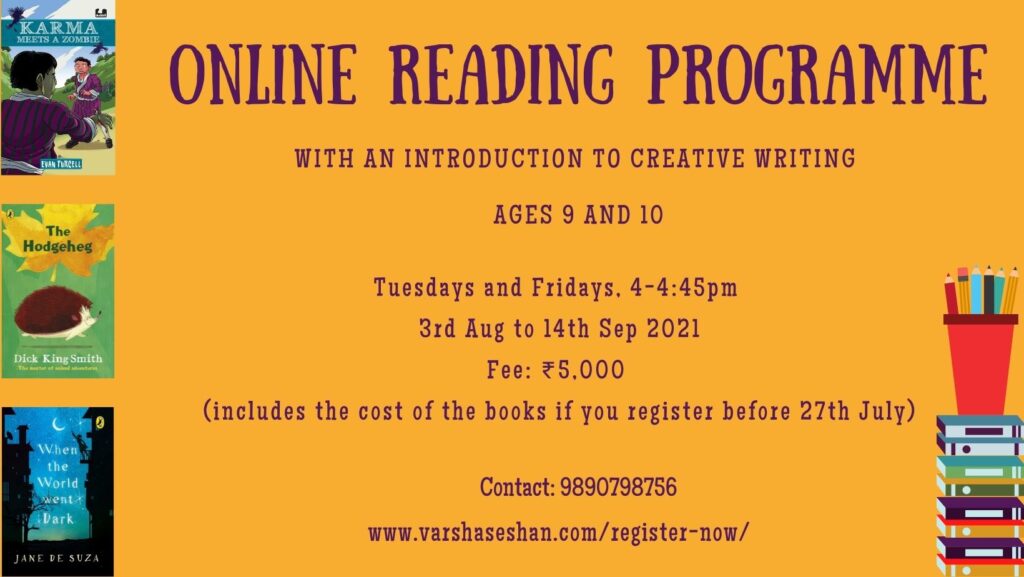
July 13, 2021
Daydreaming! Sigh. You can be what you want to be. You can do what you want to do.
And Dev is the ace daydreamer.
In The Absolutely True Adventures of Daydreamer Dev, the boy embarks on three adventures. He climbs Mount Everest, travels along the Amazon and then across the Sahara. Each adventure is real to him, and so, of course, he has no time to pay attention to mundane things like school and marks. In fact, even when he is being told off by his father, he’s off on another flight of fancy.
Dev’s stories are full of possibility, and that’s why I chose to include them in my reading programme. Imagination has no limits; let’s see how far-fetched we can get!
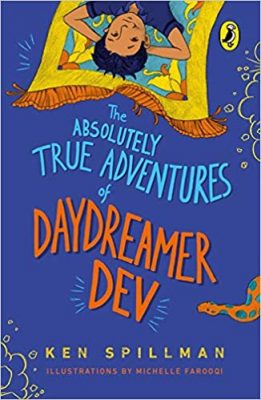
Look at the cover of The Absolutely True Adventures of Daydreamer Dev. There he is, lying on a Kwality Carpets carpet and dreaming. A carpet can take you on an adventure, can’t it?
What else? What could a stick be, if you use your imagination a little? What about a little felt cloth? I’m looking forward to exploring a whole range of possibility!
Anything sets Dev off on a daydream – sticky eyes, a hot wind, a conversation …
What about you? What was the last place you read about? And what would you do if you were suddenly transported there?
A similar ‘where’ activity involves a map. I remember using a map with younger children at a British Council workshop once, and I was amazed. I’d love to introduce the children to different parts of the world. Each story in Ken Spillman‘s collection is dedicated to someone. Let’s find out who they are and what they have to do with the place where the story is set!
Language, culture, customs – we experience so much when we travel! Dev learns about piranhas on the Amazon, he meets a Sherpa woman when he climbs Mount Everest, and he learns about amana while traversing the Sahara.
It’s been a long time since most of us travelled, but the joy of travelling lies in the stories we create. I think I’m being slightly ambitious here, but I would love for the children to create a picture postcard about any travel experience they’ve had. And if I can have them send postcards to one another, all the better!
What’s a dromedary? What about a caiman?
Animals are fascinating, more so for children. I would love for the children to talk about one unusual animal they’ve heard of or seen. I’m sure I’ll learn a lot!
REGISTRATIONS ARE NOW CLOSED FOR ALL MY READING PROGRAMMES.
The next batches begin in the first week of October. If you would like to receive an email notification when I open for registrations, please fill this form. Alternatively, follow me on social media – Facebook, Instagram and Twitter – for regular updates.

July 10, 2021
“Moin and the Monster was my favourite book because there’s a sequel!” said one child, holding up Moin and the Monster Songster.
“Mine was The Very Glum Life of Tootoolu Toop,” said another. “It was mysterious and magical!”
“I liked Fantastic Mr Fox. But my all-time favourite is The Witches.”
And in the midst of all that, one child held up Dragonflies, Jigsaws and Seashells, her eyes shining as she told me she got it, was reading it and loved it so far.
How could I not have enjoyed this reading programme? Six children, three books, 12 online interactions. It was perfect in so many ways!
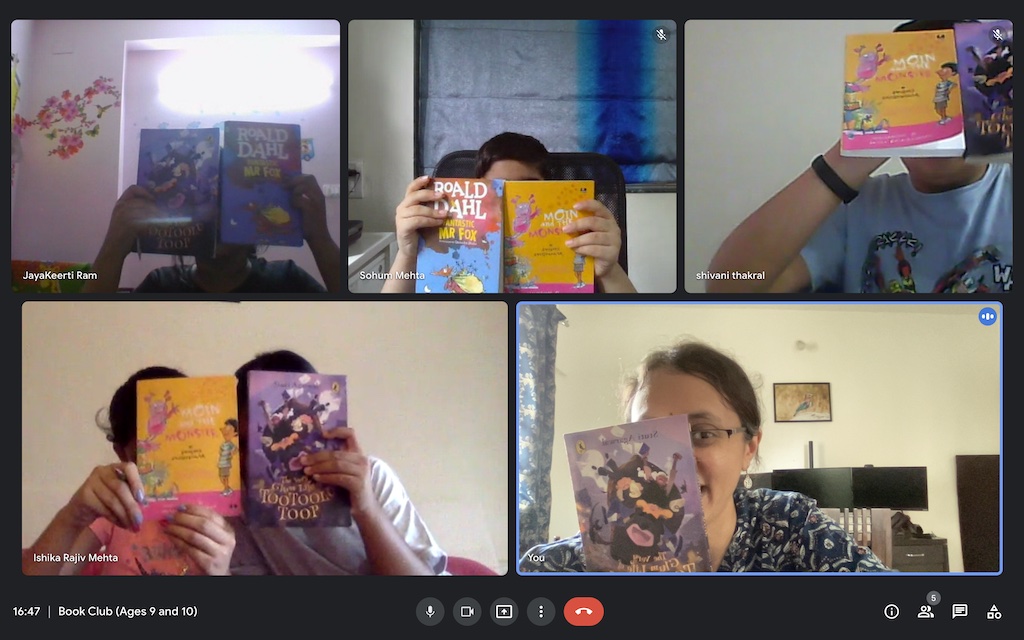
The first book we read together was Moin and the Monster. With this one, we did an all-time favourite activity – creating a monster together and naming it. Then, the children worked with rhymes and then made a monster rhyme of their own. Shapeshifting creatures, monsters hiding under the bed and jumping out of windows, monsters with superpowers – I met them all!
The written activities around this classic were all about limericks. How do we write a limerick? How can we pay attention to the rhythm of the poem when we work with rhyme?
One child wrote a set of limericks that were also acrostic poems – poems about SHAPE, CLOUD and SPACE. I love it when children are ambitious enough to try something new!
A quick game followed by an introduction to characters, setting, plot and structure made our writing activities for The Very Glum Life of Tootoolu Toop quite intensive! We worked on creating magical characters of our own followed by a quick free writing activity. The best way to finish a workshop on reading and writing is with the possibility of more stories and unbridled creativity.
REGISTRATIONS ARE NOW CLOSED FOR ALL MY READING PROGRAMMES.
The next batches begin in the first week of October. If you would like to receive an email notification when I open for registrations, please fill this form. Alternatively, follow me on social media – Facebook, Instagram and Twitter – for regular updates.

July 6, 2021
Another reading programme, another delightful hOle book! I remember reading a YA book by Rupa Gulab, Daddy Come Lately, and I enjoyed it. How would a chapter book be?
The answer? Lovely.
Sandy, aka Sandip when his mother is angry, makes a new friend, Aftab, who needs rescuing from Mrs Gupta, the witch next door. The problem is that he needs to sneak Aftab into his house, feed him and give him a place to stay. And of course, Sandy has got to be braver than Aftab when it comes to an adventure of this sort. After all, Sandy is a whole year older.
I’m sure this hOle book is going to be equally fun to read at my book club! Here are some bookish activities we’re going to do.
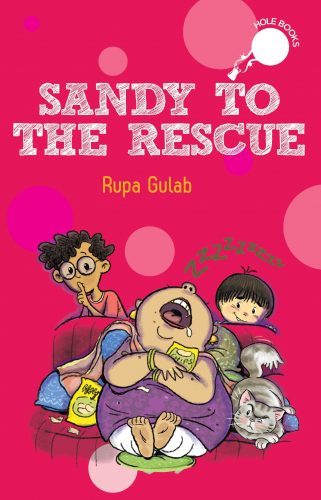
‘It’s greeny blue, not bluey green. It’s, um, grue!’
‘You need spectacles,’ Aftab scoffed. ‘It’s not grue, it’s breen!’
What words can you make up by combining two words? What do these new words mean?
Aftab hides under the table. And in the bath tub with enough pillows to make him comfortable.
Where would you hide? Make a list of your favourite hiding places. Where would your friends (or parents) NEVER find you? Do you have any secret places?
Write a secret note and hide it in a place where only you can find it again! Show us the note at the end of the reading programme! (Don’t worry, you don’t have to read it out to us!)
Sandy to the Rescue is full of similes. Sandy’s mother’s tummy is like a football. Mrs Gupta is like a witch. Her bhindi tastes like snot. Sandy’s heart races like a sports car.
What funny similes can we come up with at the book club? I can’t wait to find out!
REGISTRATIONS ARE NOW CLOSED FOR ALL MY READING PROGRAMMES.
The next batches begin in the first week of October. If you would like to receive an email notification when I open for registrations, please fill this form. Alternatively, follow me on social media – Facebook, Instagram and Twitter – for regular updates.

June 22, 2021
And just like that, the third and last guest session at this edition of my online creative writing programme is over! This one was an illustration workshop, conducted by children’s book illustrator and author Tanvi Bhat.
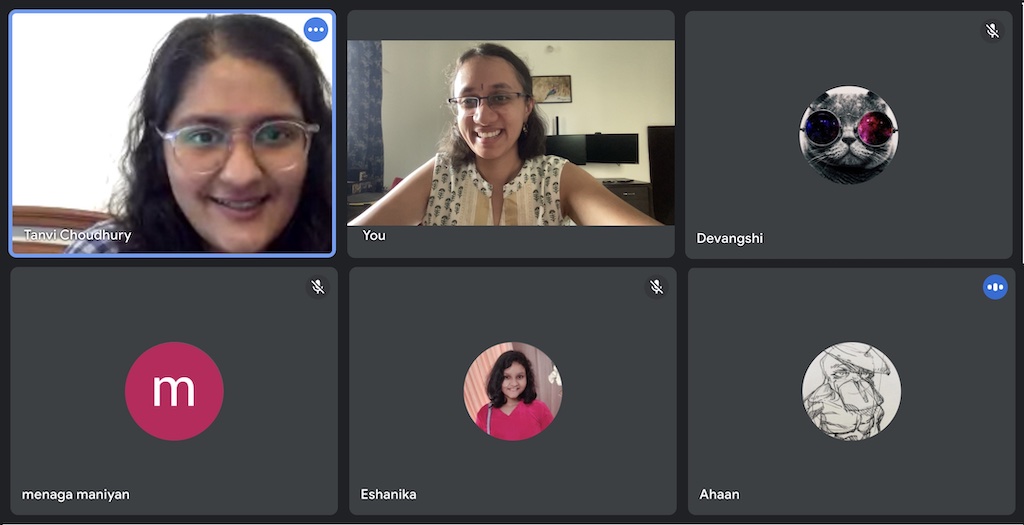
As always, the participants had so many questions! Here are a handful.
How do we create our own style of illustration?
I loved how Tanvi explained that finding your own style is not as important as the content. Isn’t that the same with writing too?
I also found interesting the idea that an illustration does not have to be perfect; it has to carry the story. I think, here, the idea of ‘perfect’ is well worth examining. As a child, I was disturbed and annoyed by pictures that were untrue to the story, but if the big toe were on the wrong side of the foot, would I even notice?
How long does the process take?
The eternal question. Children are often aghast at how long it takes for a book to become a book. In fact, the illustration happens much faster than the rest of it!
How do you get a commission?
Visit the websites of publishers and follow their guidelines. They’ll get in touch when they have a project that they feel will suit you.
Finally, Tanvi gave them an exercise – creating thumbnails for the illustration of a story. Four participants shared their work during the session, but for the rest, with all the questions and interaction, we ran out of time!
May 30, 2021
Yesterday’s guest session was full of stories! While we are familiar with Long John Silver and Davy Jones’s locker, how many of us are equally familiar with Kanhoji Angre and the pirates of the Malabar?
We began with a discussion of myths, legends, and historical fiction, and this, I think, is an important idea that is well worth repeating. A myth is not history or historical fiction. It is a story created by human beings in an attempt to make sense of the world. Even if a myth helps us understand something about the time when it was created, it isn’t a true tale.

A legend is not true either! My mother, Dr Radhika Seshan, told us the story of the emperor Jahangir and his bells of justice. Legend says that a donkey rang one of the bells one day, and Jahangir proclaimed that a donkey deserves justice too. Is the story true? We have no idea, but legends are often built around people who slowly, through stories, emerge as beings larger than life.
What, then, is historical fiction?
Historical fiction has a very sound foundation in fact, based on evidence. This is what makes it difficult to write. If we write about Kanhoji Angre or Ram Koli, we need to understand their times and set our stories accordingly. We need to know about the boats they used and where they lived. We cannot make them use Mediterranean ships! We also cannot change the course of history.
What, then, can we, as writers, imagine? We can imagine their conversations. We can imagine what went on in their heads. Kanhoji Angre was clearly a strategist. How would he have planned his course of action? Would he have been afraid the night before an attack? Or excited? The emotional and mental aspects are ours to play with.
I’ve given the children who attended the workshop a couple of writing assignments based on yesterday’s session. I can’t wait to read them; I’m sure they’ll be fun!
Mark your calendars – the next workshop is on illustration and will be conducted on the 19th of June! More details as soon as I open for registration.
May 29, 2021
And just like that, the playwriting module of my creative writing programme is also over! We read two plays, played with props, explored dialogue, imagined the stage, examined the differences between writing scripts for stage and for screen … And I’m exhilarated. As always, the generosity of the community of teachers and writers online is astounding. Some resources work for me; some don’t, but each one I come across is useful.
So, it’s my turn. Here are a few activities I used successfully in class this time.
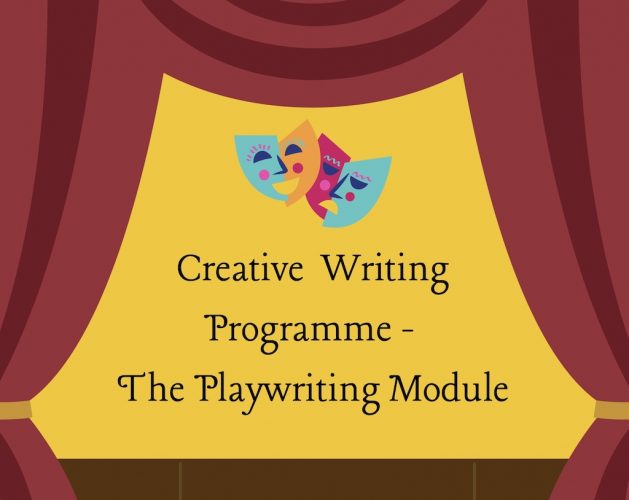
Writing dialogue that reads naturally is challenging. Even though I have been writing for so long, I sometimes find myself using long, winding sentences in dialogue and have to remind myself that we don’t regularly use long sentences beginning with ‘although’ or ‘despite’. And can you imagine using them when you’re excited?
This led me to create an activity that is ideal for small batches of online creative writing programmes. Give the children a situation and let them speak. Record what they say and play it back to them. What do they notice? Do they use complete sentences all the time? How long are the sentences?
Here are two topics I created for them. Feel free to use them too!
Short videos always help, even if the children listen to just your voice yet again. If nothing else, a video gives them a break from having to focus on your face! Based on everything I encountered and everything I read, I made a video about the common mistakes made while writing plays.
I use sounds in class all the time. Most presentation softwares have some sounds that you can insert into your work. Playing short sounds and asking children to describe them is a way to make children pay attention to more than just the visual world around them.
This time, I used a linked series of sounds – a creaking door, the clopping of shoes on wood, a wolf howling and wind. This led us, of course, to a discussion of genre and how to make different kinds of plays come alive.
Reading what children have to say about a module that is over is always heart-warming. Even though the sheer amount of work they share on the forum speaks volumes, reflections like these are reaffirming!


May 21, 2021
I love Anushka Ravishankar’s books. Whether it’s Moin and the Monster or Captain Coconut or At Least a Fish, I find myself chuckling as I read, shaking my head at her wacky humour.
Ana, the protagonist of At Least a Fish, wants a dog. She really wants a dog. But her parents go and get her fish instead – not one, but three! Ana’s friend Zain would call them Fishyone, Fishytwo and Fishythree, but Ana being Ana calls them Socrates, Aristotle (Totty for short) and Plato.
That’s just one of the dozens of crazy things in the story. From a dragon in a filthy pool to a dog who thinks he’s a fish, At Least a Fish brims over with humour and madness. I can’t wait to read it at my reading programme!
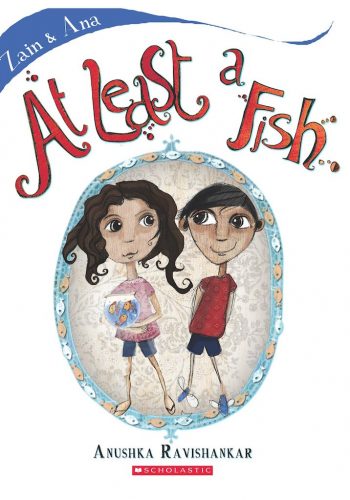
At Least a Fish is such a wonderful book to talk about differences – both obvious ones and not-so-obvious ones. There’s one hilarious page in the book where we have a list of differences between a dog and a fish. There’s also a lovely illustration of a fish mutating into a dragon. What happens there?
From a simple ‘spot the differences’ puzzle to a more thought out list of differences, there’s a whole lot we can do with this idea!
Ana wants a dog so much that she writes to ‘the person who is charge of reading letters at Adopt-a-pet’. She tries to pretend she is an adult in her letter. I wonder if the children at my reading programme will figure out why she isn’t entirely convincing!
I love working with letters and one of the things I will do at my reading programme is to ask the children to write a letter of their own. Let’s see, depending on whom they choose to write to, maybe I will print their letters and post them. That promises to be fun!
Ana once adopted a frog and made Zain hide it. She now has three fish. But she wants a dog. What pets do you think are fun to have?
We won’t just discuss pets; we’ll play a game too, one that I’ve played before. I begin by asking children to make a list of ten animals. Then, they make a list of ten things various animals do – a lion roars, a hippopotamus yawns, a frog eats bugs.
Finally, one child begins.
I have a pet. It is a ____
And the next child reads the first animal on their list.
Then, the next child reads the first thing on the ‘verb’ list. The instructions take a while to explain, but the results are always hilarious!
REGISTRATIONS ARE NOW CLOSED FOR THIS PROGRAMME. The next edition of the programme will be held in August.
If you would like to receive email notifications when I launch new batches, please fill this form. Alternatively, follow me on social media – Facebook, Instagram and Twitter – for regular updates.
May 20, 2021
I spend hours scouring the internet for creative writing resources. I love those hours, even though sometimes I find myself panicking. There are so many wonderful ideas out there! What can I use? I want to use them all! At those times, I need to step away from my laptop and remind myself that I cannot do everything in twelve weeks.
The weeks always fly by once I start a writing programme. I’m more than halfway through. Here are a handful of activities I used successfully this time!
This seems like an overly simplistic activity, but it works with people (I won’t even say just children) of all ages. It is based on something I came across in the book Writing with Children, by Jackie Reilly and Vanessa Reilly and serves as a great way to begin a session on rhyme! How would you fill in the blanks?
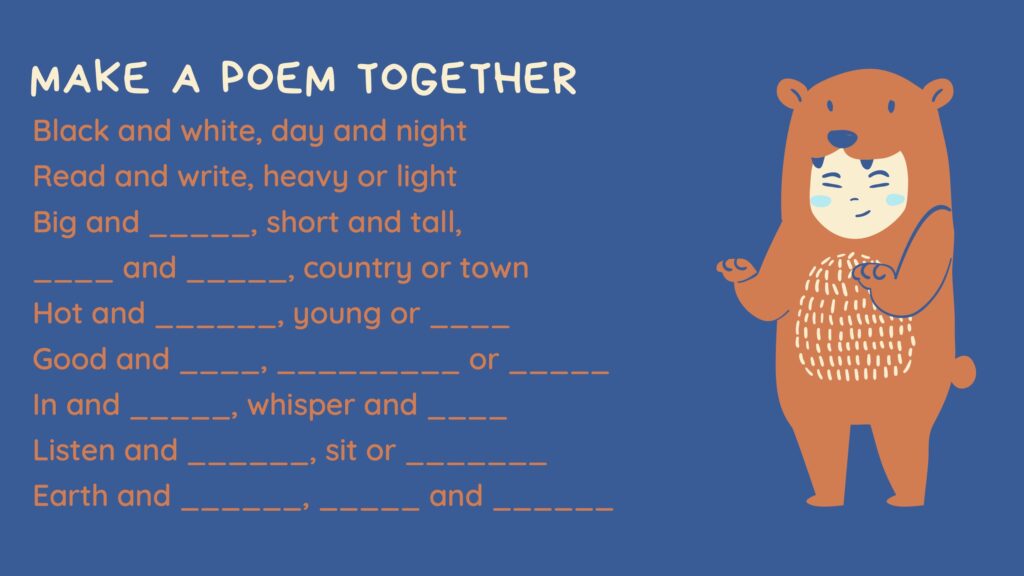
I have no idea why I’ve never done this before! Once more, adapting an activity from the same book, I chose a piece of music and then asked the children to write as I asked them guiding questions. I love how the same piece leads to completely different results!
13-year-old Shreshta felt that she was in a chocolate factory, while 12-year-old Shreya felt she was in a fun music video with shapes floating around her.
Poetry is always fun, and we did so much in four weeks. Haikus, sonnets, cinquains, riddle poems, list poetry, concrete poetry … Here’s what a couple of children have to say about it!
Another wonderful resource I discovered this time was Kenn Nesbitt’s poetry website. It’s full of not just poetry, but also step-by-step guidelines to write your own poem!
We’ve moved on to drama, and I’ve been using Drama with Children by Sarah Phillips as my prime resource book. There are several websites I’ve referred to recently, and I hope to share them soon.
Explore the Resources category to discover other reading and creative writing activities for children and adults.
May 14, 2021
Who doesn’t love Esio Trot? Teg reggib, esio trot, teg reggib!
There was a time when I knew the book so well that I could say the whole chant that Mr Hoppy tells Mrs Silver to deliver to little Alfie. Have you come across the tweet about how children’s books should not be given star ratings but ‘again’ ratings based on how many times a child asks to read the book?
By that reckoning, Esio Trot is very high up on my list!
It’s one of those perfect transition books – neither a short story nor a chapter book. Neither a picture book nor a book with just words. That makes it ideal for my reading programme for seven and eight-year-olds!
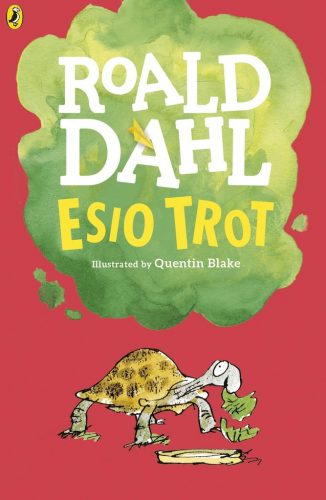
A book club is all about having fun with books. It’s about celebrating the joy of reading. And that’s why one of the things we’re going to do is talk backwards, just for a bit. Plan what you want to say and write it down before saying it aloud. Let’s see whether we can figure it out!
That’s what Mr Hoppy tells Mrs Silver. Just saying the words isn’t enough; magic words need expression.
Children love to recite poems, especially rhyming ones, so here is the perfect opportunity. During one class, I will ask them to read or recite something – with expression! How much drama can they bring into what they read?
How do children grow? How does anything grow? Can we watch something grow?
Mrs Silver does not even notice that Alfie grows to double his weight. With Esio Trot, I hope to have the children do an experiment of their own. Especially as most children come back for one edition of the programme after another, this should be fun. They’ll measure their height at the beginning of this book and then again when we end the next reading programme. Let’s see what we find!
Additionally, if we can, I’ll ask them to plant and water mustard seeds. I enjoyed doing that as a child. I’m sure they will too!
REGISTRATIONS ARE NOW CLOSED FOR THIS PROGRAMME. The next edition of the programme will be held in August.
If you would like to receive email notifications when I launch new batches, please fill this form. Alternatively, follow me on social media – Facebook, Instagram and Twitter – for regular updates.
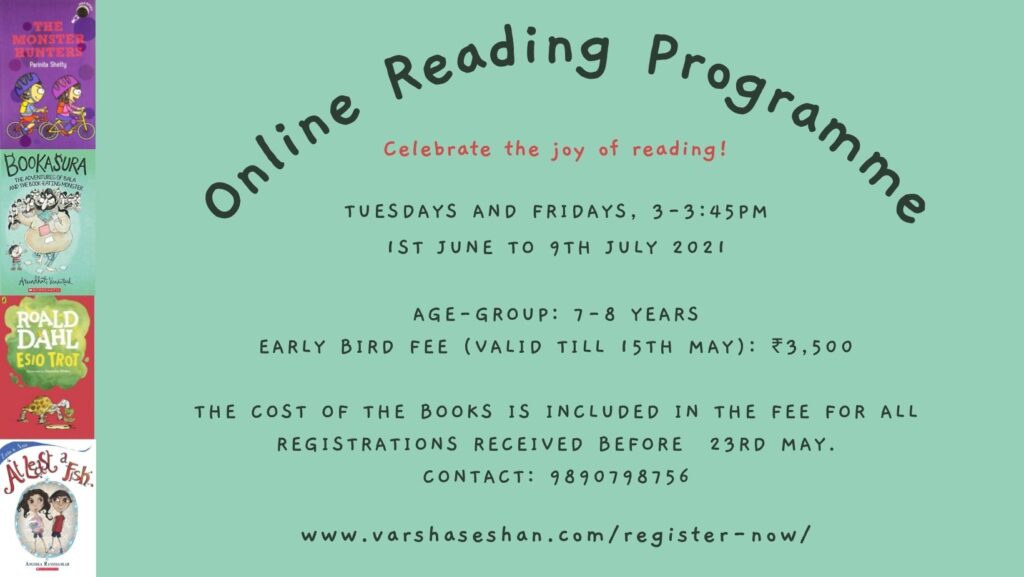
May 13, 2021
I love sharing stories with children, and this time’s batch of seven and eight-year-olds was even more fun than most. With each workshop I conduct, I treasure the stories we create together. The little anecdotes, the bubbles of laughter, the wide-eyed astonishment – these make workshops special! I wrote about a class where we spoke about monitors and Maya in a Mess; that was just the first of four books we read together, and each one brought joy.
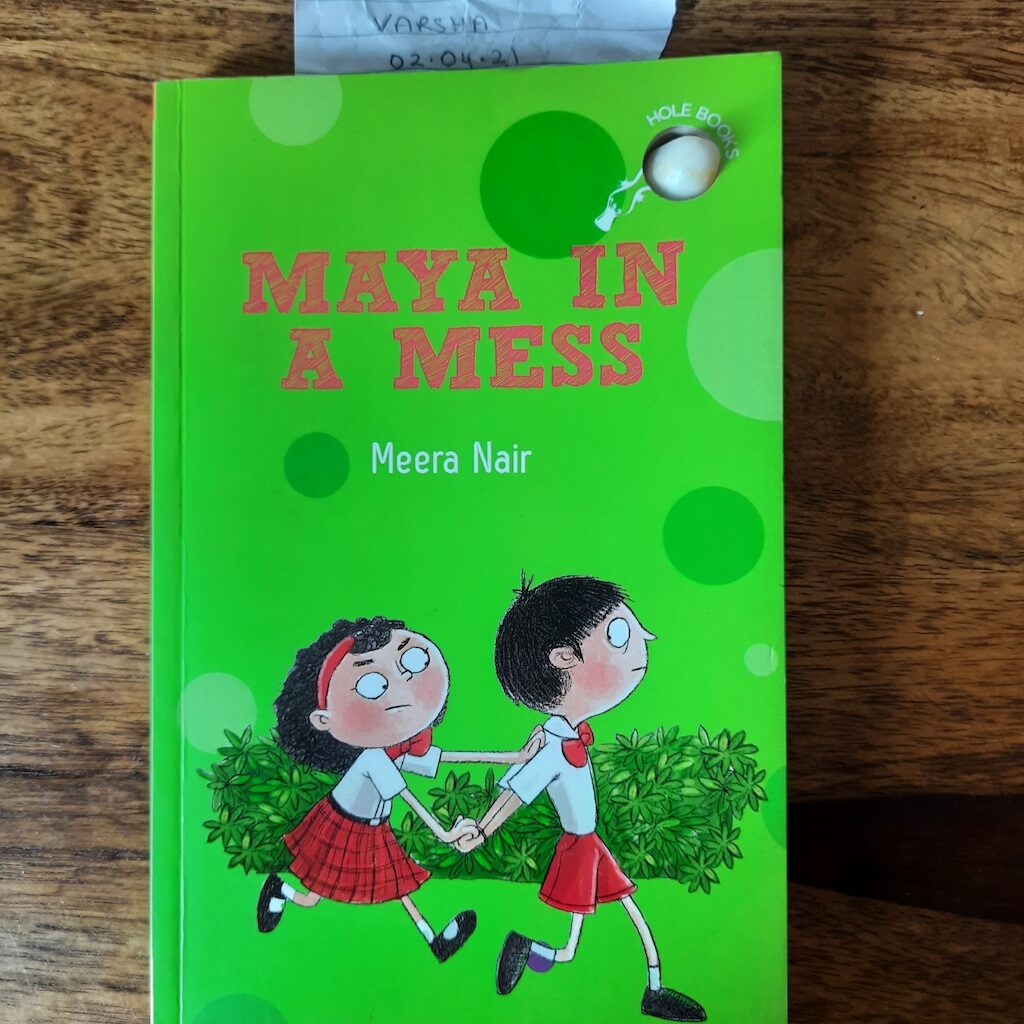
One of the activities we did with the book was to try to keep something safe for six weeks. Maya loses the cupboard key. How about the children at my workshop?
During the first class, I asked them to find something smaller than the hole in the hOle book, wrap it in paper and keep it safe. I did it too, as you can see, and the paper has my name and the date on it.
During the last class, I asked them to show their little treasures to me, and nearly all of them had kept their ‘little thing’, as we all called it, safe!
Spellbound! by Nalini Sorensen was fantastic fun. We made up magic words and had all kinds of conversations.
“Why is the pimple on Weyona’s nose red on the cover? What mood is she in?”
“Does Oat-Penguin Oil really contain penguins?”
“Why didn’t they show us a picture of Weyona after her annual bath?”
Nalini was kind enough to answer the first two questions for us. As for the third, I asked the children to send me pictures!
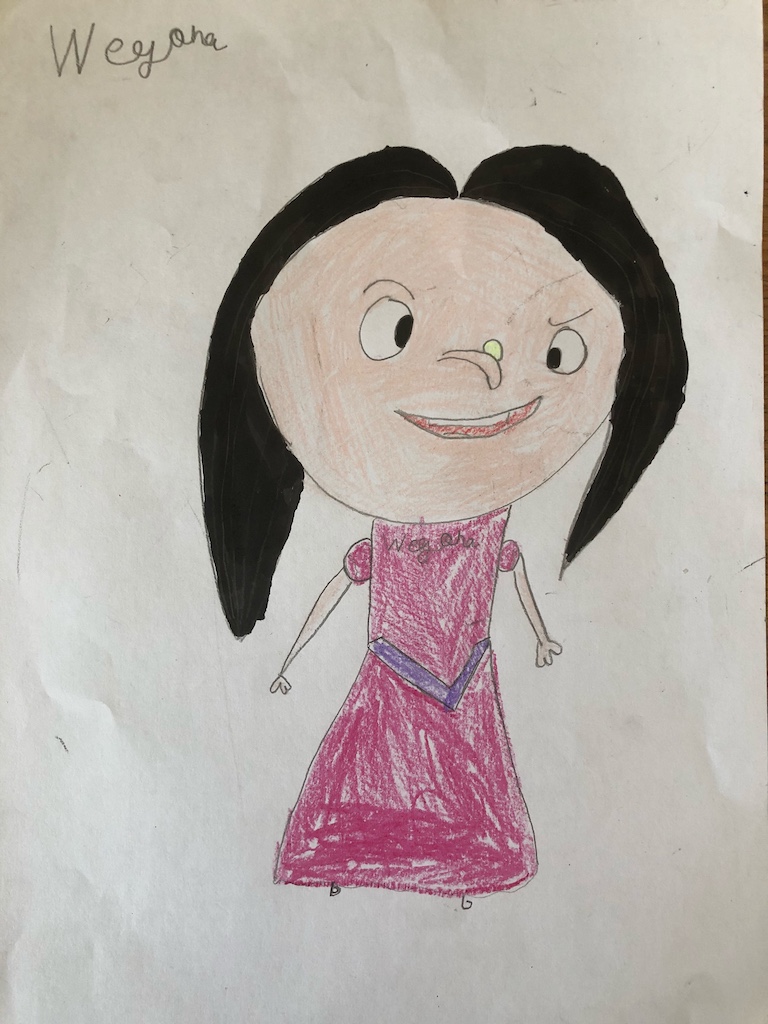
– Zayn
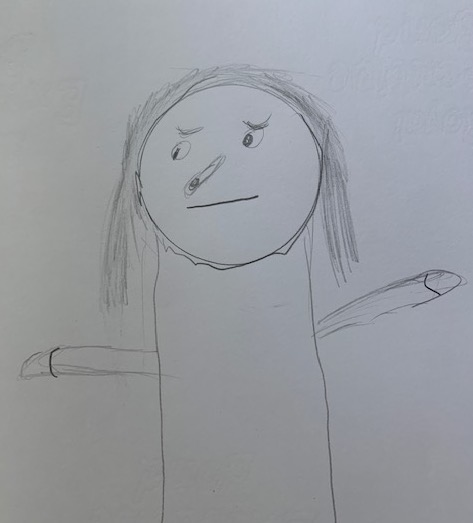
– Sohum
It’s amazing how much fun we can pack into two hours of class time because this is just the tip of the iceberg!
Our third book was The Absent Author, and this was was delightful. For me, reading programmes are about having fun. In the story, we have a character called Ruth Rose who always dresses from top to toe in a single colour. So, we did that. We chose the colour green – because the absent author’s favourite colour is green, because the story takes place in Green Lawn and for other reasons I shall not reveal. It was such fun!
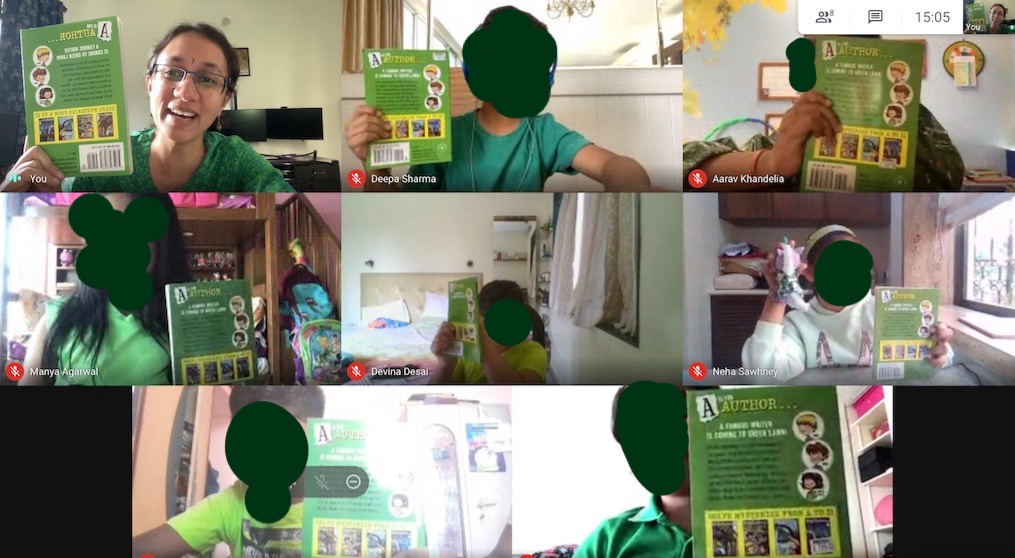
I loved the guesses the children made as we read on and the mischief in the faces of those who’d already read the whole book. A few snippets:
“It shouldn’t be kidnapped, right? It should be adult-napped!”
“If they want to check if the author actually came to the hotel, why don’t they just look at the CCTV footage?”
“The book was published in 1997, so they would not have had CCTV cameras!”
“What? No CCTV?”
“But cameras were there in 1997. Why didn’t they have CCTV?”
Of course, we also created detective clubs of our own. How could we not?
One child created the Thriving Three – comprising his parents and him. Another said her club consists of her dog and her, and anyone else who wants to join would need to do a test. Yet another created the Lime and Lemon Detective Agency. I promised to pass on their coordinates to anyone who had a mystery that needed solving!
The fourth book we read was Book Uncle and Me. For most of them, it was their first book in verse. They took a while to wrap their heads around it, but it was fun!
As Book Uncle has the BEST recommendations ever, I asked the children to create a list of books for me – books they think I should read. Here are a few they suggested that I have not read yet!
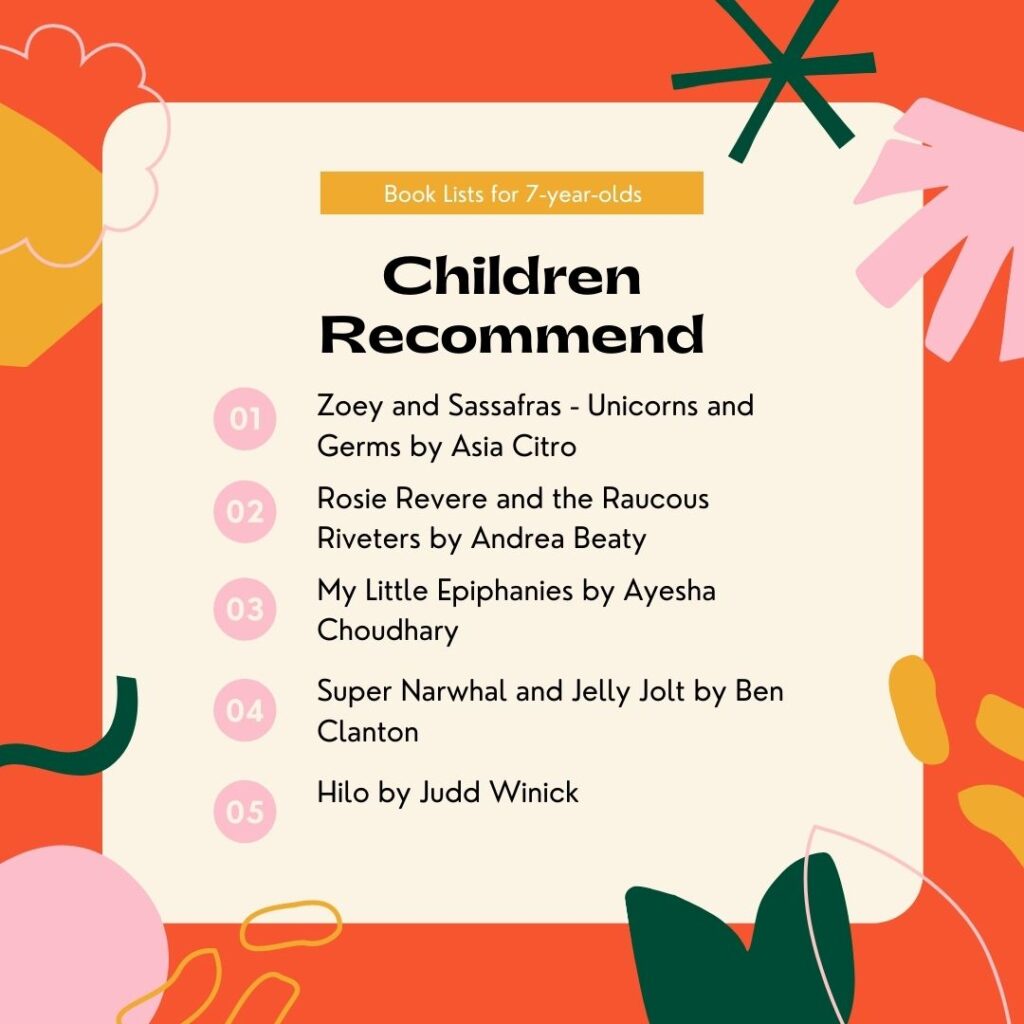
The next edition of my reading programme is here! This time, we’re going to read The Monster Hunters, Bookasura, Esio Trot and At Least a Fish. On popular demand, I have not one, but two batches of this programme – a weekday batch and a weekend one. Children from Mumbai, Surat, Chennai, Hyderabad and Idukki (which I had not even heard of!) have signed up so far. Join them?
May 12, 2021
Fantastic Mr Fox is a classic. And the combination of Roald Dahl and Sir Quentin Blake is magic.
I’ve never yet chosen a Roald Dahl for my reading programme because I reckoned that most children would already have been exposed to his books, and a book club is about discovering books you haven’t read before. Yet, as I mulled over what to include this time, I asked myself, again, what the purpose of a reading programme is. Often, I use the tagline ‘Celebrate the joy of reading’. If it’s about the joy of reading, how can I not include books I’ve adored and devoured as a child?
Rereading Fantastic Mr Fox now, I’m astounded at how much I liked it when I was younger. I was never one to like disgusting humour. I didn’t like toilet jokes. I didn’t like anything that was yucky. What made Dahl different?
I think, possibly, it was the fact that the disgust was not the point of the story. Also, when Mr Fox and family are so dapper, the whole thing made sense in my neat and orderly universe.
At my reading programme, I’m going to explore all this. I’m going to explore why I loved Dahl as a child and why I still admire his books today.
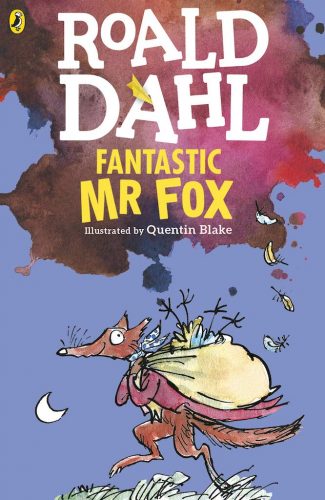
This reading programme has a strong element of creative writing. With Dahl, there’s so much we can do to play with figurative language!
What better way to understand and explore language and wordplay?
I would love to say that all children love animal stories, but I am wary of generalising. I do know, however, that practically every child I’ve met loves animal stories.
Though this is not a full-fledged writing programme, I do introduce the concept of genres. Animal stories can take so many different forms. I’ve worked with The Sheep-Pig before; it’s time to do Fantastic Mr Fox. My head is exploding with ideas of written activities we could do – anthropomorphic characters, environment stories, traditional tales of wit … Let’s see what the children come up with!
Humour is close to impossible to teach. Often, when we begin to dissect humour, it is no longer funny. At the same time, however, I think conversations about humour are enlightening.
Why do some things appeal to us while others appeal to someone else? Is there a clear distinction between quirky and odd? Can anyone identify what humour is all about or understand how disgust is linked both to humour and to horror?
REGISTRATIONS ARE NOW CLOSED FOR THIS PROGRAMME. The next edition of the programme will be held in August.
If you would like to receive email notifications when I launch new batches, please fill this form. Alternatively, follow me on social media – Facebook, Instagram and Twitter – for regular updates.
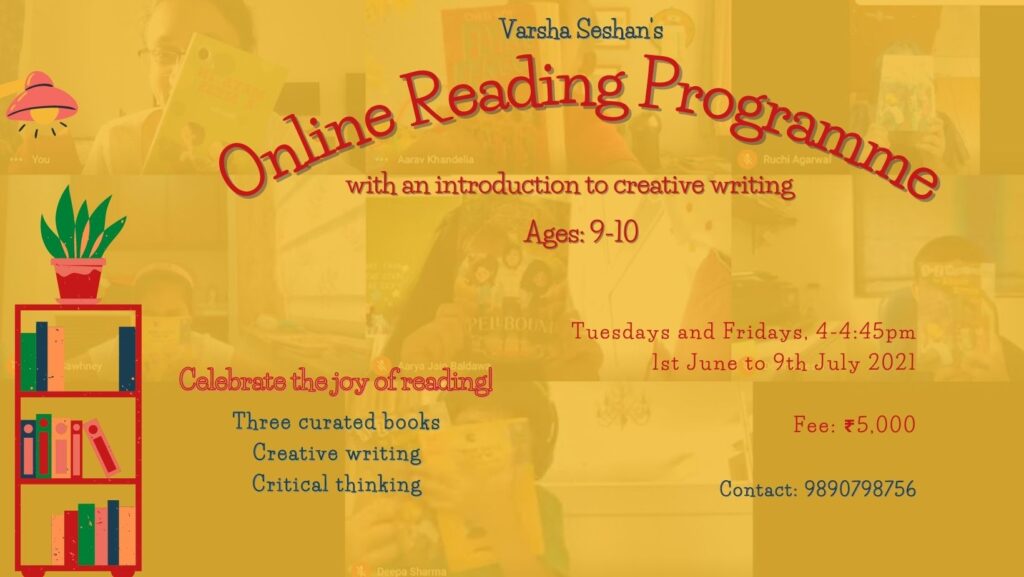
May 1, 2021
I’ve received an overwhelming number of queries this time around, and I’m not surprised. Summer holidays! Registrations are now open for two reading programmes beginning on the 1st of June.
Do note that with lockdowns in several places, book deliveries are experiencing delays. I will try to get the books to you in time for the programme, but the sooner you register, the easier it will be for me.
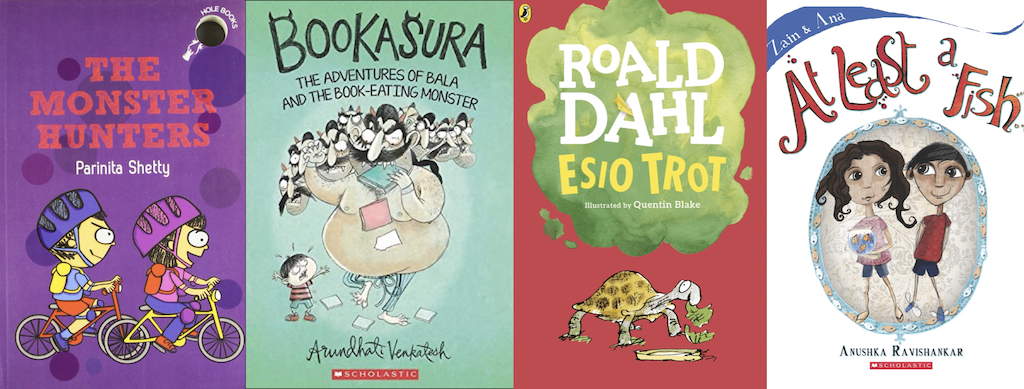
We’re on the fourth edition of this programme, and the four books we will read this time are The Monster Hunters by Parinita Shetty, Bookasura by Arundhati Venkatesh, Esio Trot by Roald Dahl and At Least a Fish (Zain & Ana Book 1) by Anushka Ravishankar.
On popular demand, I have also launched a weekend batch of the same online reading programme!
Dates: 1st June to 9th July 2021
Dates for the weekend batch: 29th May to 17th July 2021
Online interactions: Tuesdays and Fridays, 3-3:45pm (12 online interactions)
or
Saturdays, 2-3pm (8 online interactions) –
Age-group: 7-8 years
Early bird offer (until the 15th of May): ₹3,500
Fee: ₹4,000
REGISTRATIONS ARE NOW CLOSED FOR THIS PROGRAMME. The next batch will begin in August.
If you would like to receive email notifications when I launch new batches, please fill this form. Alternatively, follow me on social media – Facebook, Instagram and Twitter – for regular updates.
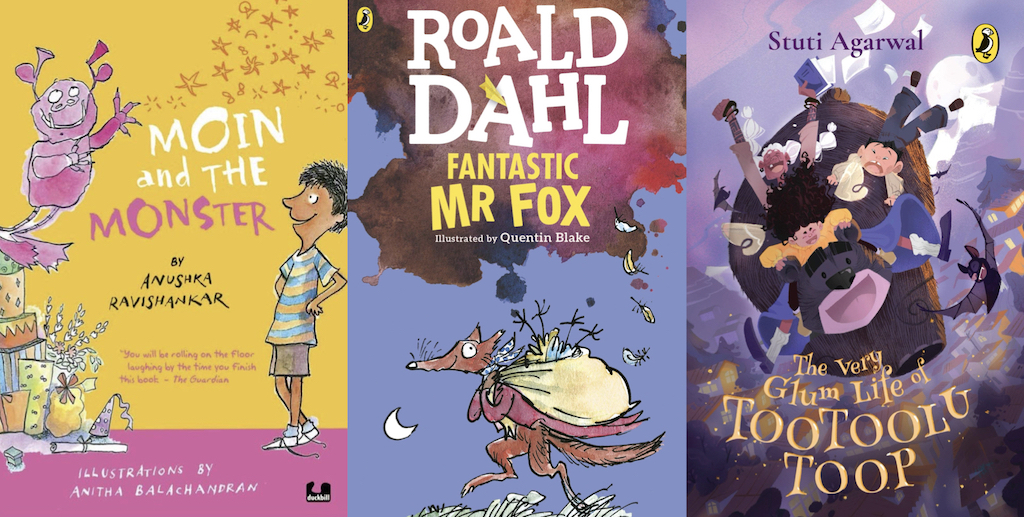
Here’s the second edition of my online reading programme for ages 9-10! There is no weekend batch for this programme. It is six weeks long and involves 12 video interactions. However, instead of reading four books together, we read just three. This is because one session every two weeks is devoted to exercises that introduce creative writing, closely linked to the books we read.
This time’s books are Moin and the Monster, Fantastic Mr Fox and The Very Glum Life of Tootoolu Toop.
Dates: 1st June to 9th July 2021
Online interactions: Tuesdays and Fridays, 4-4:45pm
Age-group: 9-10 years
Early bird offer (until the 15th of May): ₹4,500
Fee: ₹5,000
REGISTRATIONS ARE NOW CLOSED FOR THIS PROGRAMME. The next batch will begin in August.
If you would like to receive email notifications when I launch new batches, please fill this form. Alternatively, follow me on social media – Facebook, Instagram and Twitter – for regular updates.
April 25, 2021
What a fun session we had with digital forensic investigator Shweta A. Chawla yesterday! The children had all kinds of questions, and all kinds of stories. Nearly every child had a story of a parent or relative receiving a call and asking for an OTP or bank details. It just shows you how close cyber crime is to us!
One child said, “We should keep changing our passwords, but it’s difficult to remember them. So I write them in an Excel sheet.” Before Shweta could respond, he said, “The Excel sheet is password protected.”
And I found myself thinking, Do I even know how to create a password-protected Excel sheet?
We spoke of how stories no longer need masked robbers going into banks with guns, and the fact that you are much more likely to encounter a hacker online than a smuggler. Sure, we love our Enid Blyton stories of smuggling and crime, but perhaps stories can reflect something much more accessible – a criminal working from home, just like the rest of us.
Finally, if we create a character who is a digital investigator, what would that investigator’s line of thought be? What questions does the investigator ask to start tracing the criminal?
Character motivations, procedures, forensics, passwords – we learned so much during the session!

This was just the first of three sessions planned for this writing programme. Mark your calendars for the next one, which will be on the last Saturday of May. Registrations will open shortly, but here’s a teaser – we’ll be talking about pirates during this one!
April 21, 2021
No, I don’t believe that every book needs to teach us something. Absolutely not. I read to laugh, have fun and unwind. Yet, every so often, I come across a book that invites discussion and makes me think.
At my reading programme for ages 9 and 10, we’re reading Flying with Grandpa. Yesterday, we were to read the section where Grandpa refuses to eat. He makes a fuss and keeps banging his fork on the table.
I paused as I reread this section in preparation for my reading session. The children at my book club had clearly said that they had never encountered adults behaving like children. The idea, to them, was absurd. I knew we needed to have a conversation – about dementia, Alzheimer’s and growing old. There would be no better time than this, but how could I go about it?
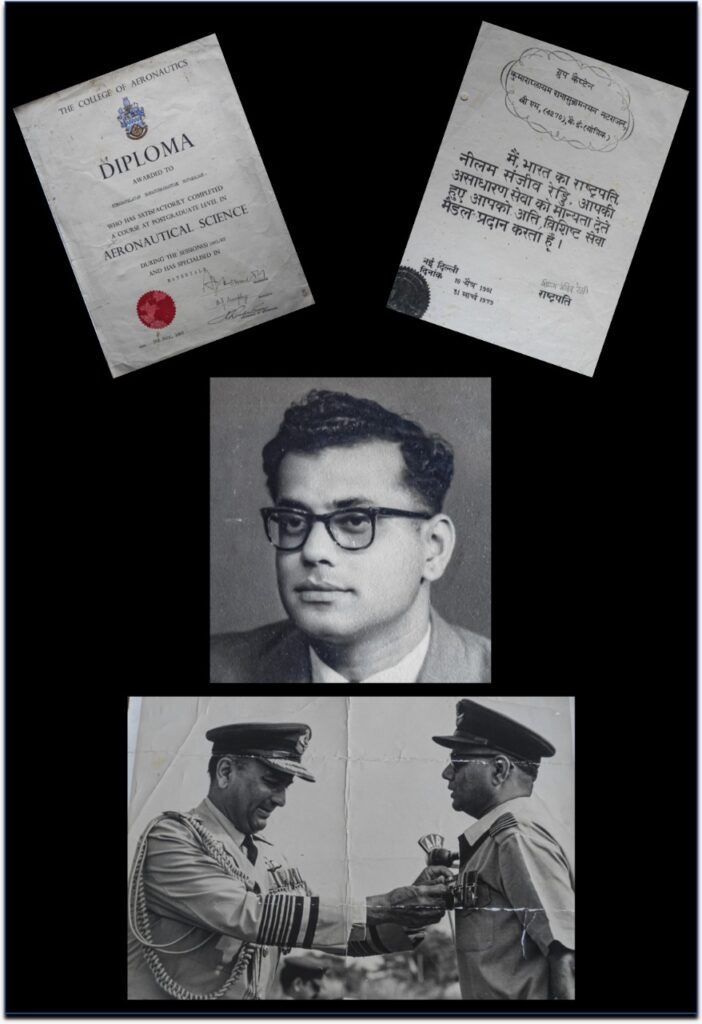
I lost my grandfather six years ago. He was a remarkable man, a retired Air Vice Marshal, whom I respected and loved.
In 2015, he when my sister Nisha and I went to visit my grandparents in Coimbatore, he was already declining – and rapidly. It was frightening and saddening at the same time.
One day, the two of us were sitting on the bed, talking together, and my grandfather paused at the doorway. He stared and demanded of my grandmother, “Who are those two?”
“The children!” replied my grandmother, horrified.
“What children?”
“Nisha and Varsha – our grandchildren!”
“Oh.”
Even with that response, we knew that grandfather had no idea about us. He was confused, but he just let it go.
We encountered just brief moments of confusion, but it isn’t the same for everyone. Plus, neither Nisha nor I was a child when this happened.
How do we talk to children about dementia? How do we build empathy and prevent them from ridiculing the idea of an adult forgetting how to eat?
As I thought about all of these, I discovered video after video on how to explain Alzheimer’s to children. Here are a couple I used:
The length of the first video is perfect! To introduce what dementia is in a sensitive, gentle way, I think it works very well.
The second video is lovely too, though slightly long to share with children. I did use parts of it because it’s clear and has a person who is sundowning explaining what Alzheimer’s does to people.
And finally, books. I wrote about Where’s Grandma?, a book I learned about from Maria Alessandrino at the AFCC four years ago.
In their own gentle ways, books prepare us for what can be. At my reading session yesterday, I showed the children pictures from Where’s Grandma? and we continued to read Flying with Grandpa.
When we reached the section where Xerxes helps his Mamavaji to eat, I think there was just a little more understanding, a little more empathy. And that made me more than a little glad.
April 17, 2021
During my writing programme last year, I met many children who wanted to write detective stories. What would a detective story involve? How did investigations really happen?
This got me thinking.
What could I do that would be new and unusual? I’ve never solved a crime. I have no inside knowledge. And if children (and I!) don’t want to write about smugglers and private islands and the like, what detective stories can we write?
My answer was cyber crime. And that led to the very first guest session of my creative writing programme.
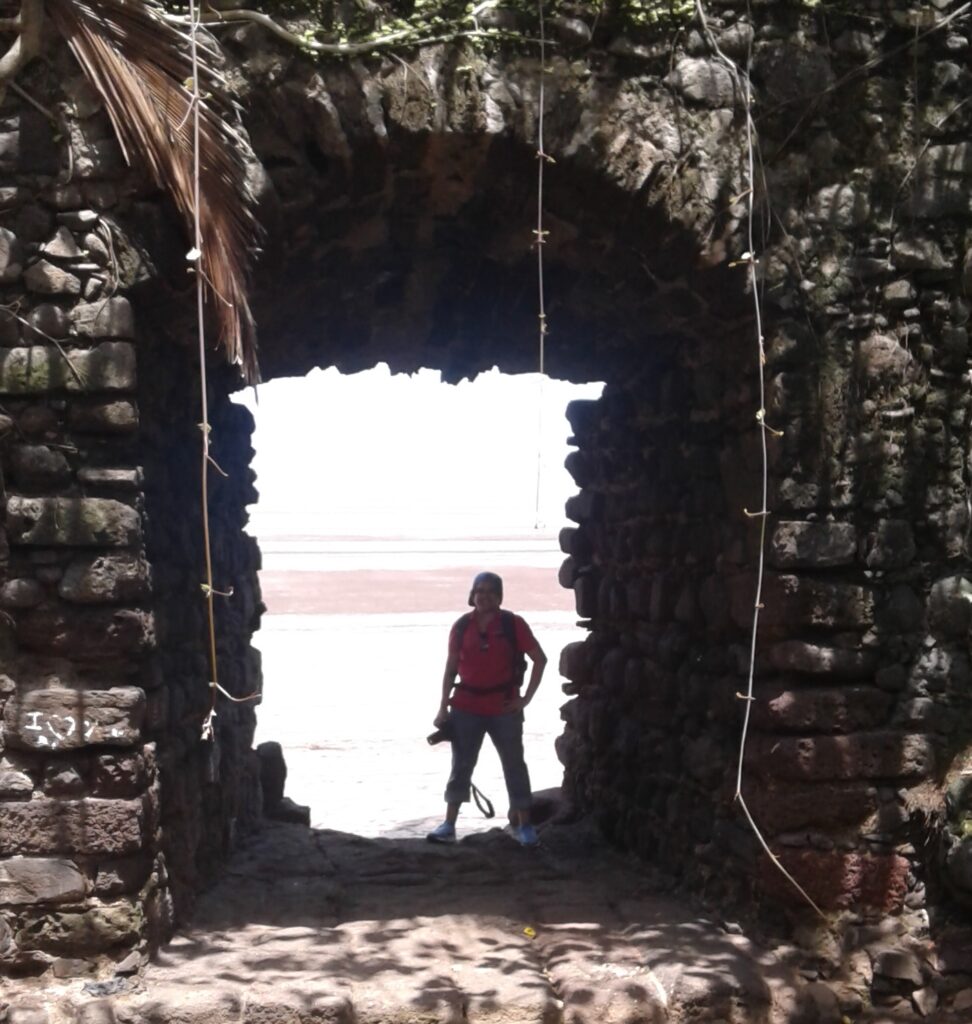
Shweta A. Chawla is an independent digital forensic investigator with over 15 years of experience in digital forensic and cyber investigations. She is the founder and chief investigator at SC Cyber Solutions, and has acted as consultant to various police departments in investigations into cyber crimes. Shweta is a member of the prestigious, international High Technology Crime Investigation Association, as well as of the Cyber-investigation Analysis Standard Expression (CASE) community.
As this is a guest session at my writing programme, participants who are part of my current batches will be part of it at no additional cost. However, this session is also open to non-participants on payment of a fee of ₹400.
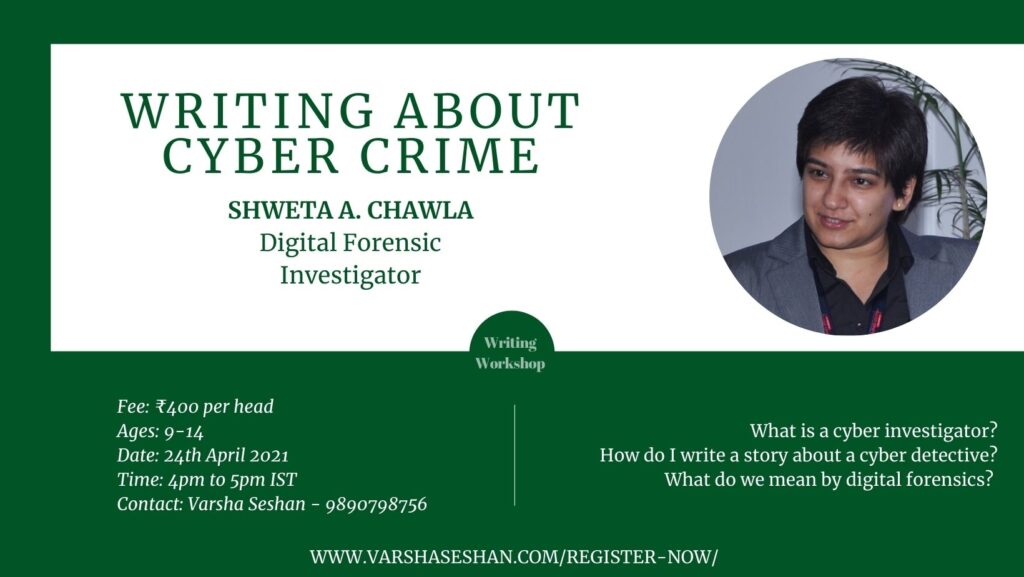
April 8, 2021

Last week, I started reading Maya in a Mess with my book club for seven and eight-year-olds. As part of the discussion, I asked them, “Have you ever been a monitor in class? How do you feel?”
“I feel like a king!” said one child.
“I love it,” said another. “You don’t have to just stand in line with the others. You can actually do things.”
“It feels good,” said a third. “You feel responsible.”
One avid reader in the batch isn’t seven yet, but she’s at par with the others. When it was her turn, she said, “I haven’t ever been a monitor.”
“Do you want to be a monitor?” I asked.
There was a minuscule pause.
“I don’t know. I’ve never been to proper school. When I was in kindergarten, we didn’t have monitors. Last year, it was all online. So I don’t know what it would be like to be a monitor.”
My heart broke just a tiny bit.
I’ve never been to proper school.
Sigh.
March 23, 2021
I discovered verse novels quite recently. I began by reading a few for young adults and then I slowly went down the age ladder. I love them. I love how much they say with such few words.
Would I have enjoyed verse novels as a child? I have no way of telling, for I was such a mix. I liked things that were familiar, so it is possible that I would have rejected them out of hand as weird. On the other hand, I was never a fan of long paragraphs, so I don’t know.
I do know, though, that I want to introduce young readers to this form, and Book Uncle and Me is ideal.
Yasmin has a mission. She wants to read a book a day for the rest of her life, and she has accomplished this for over a year thanks to Book Uncle, who not only runs a free lending library but also recommends the best books. One day, however, Yasmin discovers that Book Uncle is packing up. He’s been told he needs a permit to run his little enterprise. What can Yasmin do? Will all the books she’s read help her find a solution?
Through Yasmin, we live the life of a young reader, determined to devour one story after another. And through her, we learn about the power of the individual as well as the power of a group. Yet, like any good story, Book Uncle and Me is not about what we learn from the book. Rather, it is about what the book makes us feel and how it makes us think. What better book could one read at a book club?
Here’s what I plan to do with the book at my reading programme.
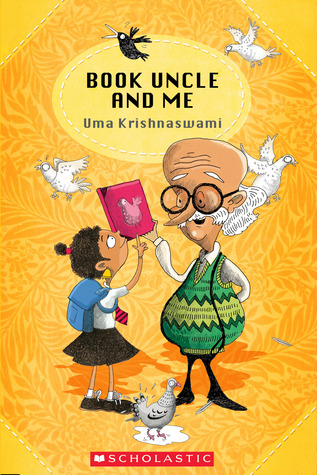
Book Uncle shares wonderful book recommendations with Yasmin, which help her discover stories she loves. A book club is the best place for children to create book lists for one another. What books would be on your “must read” list? What books make you want to read more and more and more? At the end of the programme, I hope to have at least seven (I have seven registrations so far) brand-new lists of books to read!
I love the descriptions of all those who live in Yasmin’s building! From the newly-weds to the gentleman who plays the ghatam, we meet a host of interesting characters.
So, it’s time to get creative. Who do you think would be an interesting neighbour to have? Do you think you are an interesting neighbour? Do you have neighbours who make you curious or annoyed?
Children today grow up with the idea of needing to save the world. They know they must close taps, switch off lights and reduce plastic. What else is important to them? The question will lead to all kinds of discussions, I’m sure. What is in danger? Are libraries in danger? What about bookstores? Do these need saving? How?
I hope to start this conversation by asking children to draw a map of their neighbourhood to build an understanding of the environment that makes us who we are and helps us grow. Which parts of their locality go unnoticed? Which ones are important?
Book Uncle and Me is the fourth book we will be reading at my reading programme for ages seven and eight.
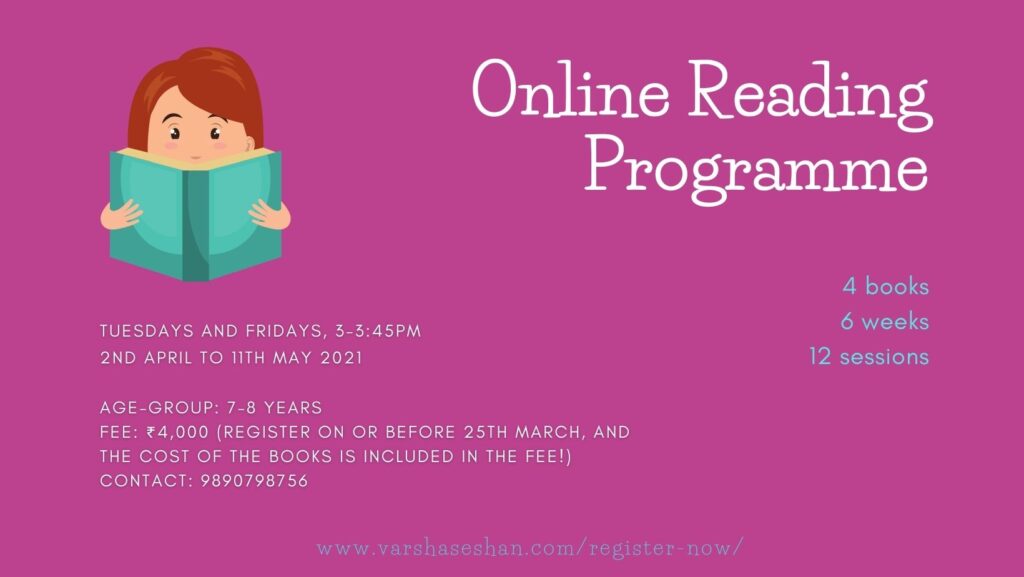
March 20, 2021
Wisha Wozzariter.
Say it aloud.
Wisha Wozzariter was what pushed me to launch this reading programme!
Several parents have called to ask if my online creative writing programme is suited to children who want to begin the process of writing. The answer is ‘no’ because, for the most part, the children who enroll already enjoy writing. They write regularly and don’t find written assignments a chore. For children who don’t already write, the course could be daunting, and the last thing I want to do is to put children off writing altogether!
So I wanted something that would introduce creative writing in smaller, more accessible chunks. And just as I was thinking about it, I came across Wisha Wozzariter.
Wisha wants to be a writer. When she reads a book she loves – like Charlie and the Chocolate Factory – she thinks, “Now that’s a book I could have written.”
Enter Bookworm, who asks the all-important question – “Well, then, why don’t you?”
And so, a wonderful journey begins, a journey that takes Wisha to the Marketplace of Ideas, the Superhero Salon and the Bargain Bazaar. With Wisha, we explore protagonists and antagonists, form, structure, style and inspiration. If this isn’t the ideal book to introduce creative writing, I don’t know what is!
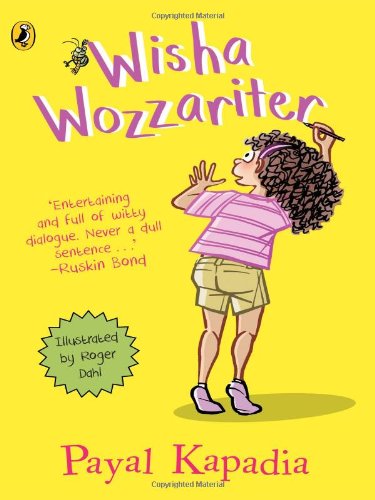
What goes into the writing of a story? Wisha wishes she was a writer. What stops her?
We’ll read this book slowly, talking about the imagination that went into the writing of the story and the ways in which these ideas are linked to our own journeys as writers. Can we have a story without a villain? What do we mean by form? When do we need to flesh out a story and when do we need to cut it down?
What if is one of the best ways to begin a story, especially when you’re stuck for ideas. A popular way of looking at many of Disney’s movies is with the question ‘what if’. What if cars had feelings? What if toys had feelings? What if feelings had feelings?
Each of these questions became a movie!
With Wisha Wozzariter, we’ll discuss a few more ‘what if’ questions. What if your protagonist was a mouse? What if you were all alone in an imaginary world? I look forward to seeing where these questions take us!
Since this is the last book we will be reading together, we will work on the actual writing process too. It’s easy to have ideas.
It’s a little less easy to jot these down.
The most challenging is to get these ideas together and write the first draft of a story. Let’s see what we can achieve together!
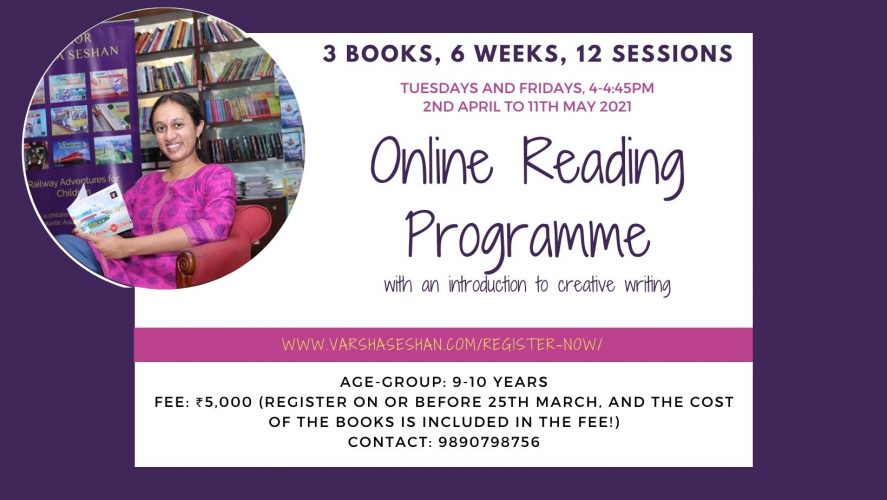
March 17, 2021
The Absent Author. The Bald Bandit. The Haunted Hotel. The Zombie Zone. Isn’t this the kind of series you could see any child longing to collect?
Book series are special and that’s why, for each reading programme, I try to introduce at least one. They’re sure shot ways of getting children hooked to reading! During my first reading programme, I introduced the hOle books with Trouble with Magic. During the second, it was the Amelia Bedelia series. Now, it’s the A to Z Mysteries.
Dink invites his favourite author, Wallis Wallace, to Green Lawn, and joy of joys! He receives a note from the author accepting the invitation! Unless he’s kidnapped, Wallis Wallace promises to come to the Book Nook and meet Dink and his friends. When he doesn’t show up, Dink has a mystery on his hands – the mystery of the absent author!
Meticulously, Dink, Josh and Ruth go through Wallis Wallace’s itinerary, trying to figure out when exactly the author was kidnapped. Step by step, they examine clues and investigate. Where could Wallis Wallace be?
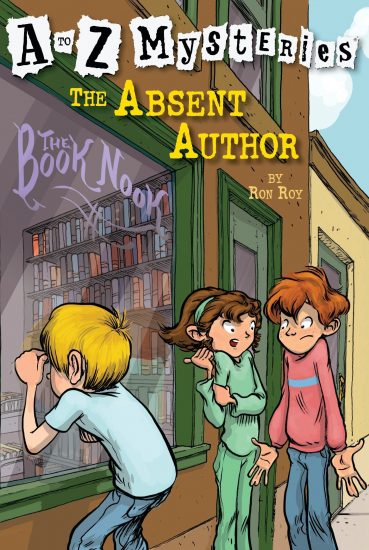
Solving a puzzle is among the most satisfying things in the world. Isn’t that what draws us to detective stories? All the clues are right there in front of our eyes.
Dink, Josh and Ruth solve the mystery of the absent author in a simple, systematic way. We’ll do a puzzle or two too – a jigsaw puzzle, a simple logic puzzle and a word puzzle!
The three young detectives solve the mystery successfully because they have with them a detailed itinerary that Wallis Wallace was supposed to follow. This is the perfect prompt to get children to write about their own days. How do they spend their days? I’ll be giving them a template that they can fill in and send back to me. Journaling is a lovely way to be more attentive, and to start the process of writing for fun.
As a child, I read so many books by Enid Blyton that I set up more clubs than I could count. I even set up clubs where I was the sole member so that I could have meetings with myself! Dink, Josh and Ruth are a gang of detective kids much like the ones I read about as a child. As we’re reading the book together at a book club, let’s have fun! We’ll think of a name for the club, perhaps make badges. I can’t wait to see what the children come up with!
March 10, 2021
When I wrote about using Friends Behind Walls for my online reading programme, the first thing I thought of doing was playing with words. Putti loves breaking words up to make sense of them. Brouhaha = brew+haha, but has nothing to do with brewing tea or being funny.
Yesterday, we thought of words like this. We thought of ‘unfortunately’ and ‘perspective’, as we hunted for humorous ideas.
“Is ‘guin’ a word?” one child asked me. Of course he wanted to do something with what a penguin is not.
One idea led to another and we came to kangaroo words. I’m not good at coming up with these, but I love the idea! A kangaroo word is one that carries a synonym of itself in the word.

We discussed just a handful in class – masculine contains the word male, blossom contains the word bloom, chicken contains the word hen. “I know this is difficult,” I told the children, “but see if you can think of another kangaroo word for yourself!
All the while, I could think of not one word myself.
By the end of class, an eight-year-old piped up, “Miss, miss! I thought of one! Instructor! It contains the word tutor!”
Do you see why I love my reading programme so much?
I did read up about kangaroo words before I conducted this session. If you’d like to discover more words, here are two sites I visited:
March 9, 2021
I read Flying with Grandpa some time ago and enjoyed it. I wanted to read it with children, but had not yet figured out how. The book is slightly difficult for ages seven and eight, the age-group I was working with.
When parents started asking me about writing programmes for readers who are reluctant writers, the seed of an idea took root. A reading programme with smaller elements of creative writing would be perfect – and there! I had the perfect setup to read Flying with Grandpa!
Xerxes wants to be like his grandfather, his beloved Mamavaji, but his mother has other plans for him. She wants him to be like JRD Tata. She is fierce and determined, pushing Xerxes to do things the correct way all the time.
But his strict mother is just one of Xerxes’s problems. His classmates tease him, calling him ‘Xerox, Xerox’. When his Navjote approaches, they make up a rhyme about not caring a jot about his Nav Jot.
What can Xerxes do to be happy? He doesn’t feel like he belongs with the others in his class. His mother is stern and proper, and he can’t even spell her profession. He just wants to be with his grandpa, who, his mother says, is a bad influence. Can he make sure that he isn’t separated from his Mamavaji? How?
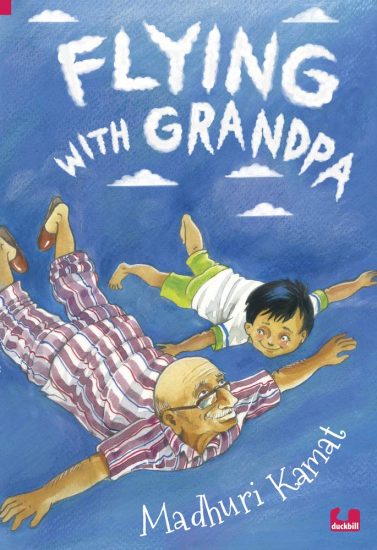
Recently, I was asked to judge a creative writing competition. I read 16 stories in all, and in four of them, the lead character was called Mary. I also encountered Brenda, Julian, Olivia and Andrew. For the most part, the stories with Indian settings had a clear moral and a fable-like writing style.
I’ve written before about why this happens, but first, it comes down to what children read. If entertaining stories are overwhelmingly about Laura and James, those are the characters that find their way into what we write. The more we read about diverse characters, the likelier we are to write about them.
A book like Flying with Grandpa is a wonderful place to begin a conversation about diversity and then go on to creating a unique character without a whitewashed identity.
‘Write what you know’ is one of the basic tenets of writing, and it’s important to discuss this with children who set out on their writing journeys. I’ve had children set their stories in Pennsylvania, only to spell it Pencilvania (without trying to be humorous). I’ve had stories about boys called Margaret living in Italy. Fantasy is great, imagined worlds are wonderful, but when we’re writing, we need to be aware of how we use characters that have backgrounds unfamiliar to us. Similarly, when we create the setting, if we want it to come alive, we need to begin with something believable – and not set a story in Zaire, South America. (I’m not making this up.)
Everything about the reading programme isn’t about writing. I want there to be space for the participants to discuss anything the book freely. Participant-led sessions are wonderful because they lead to so many conversations about what we like and dislike, as well as what we think about literature in general. I want to have fun with the book too, creating alternative endings, and using the pictures in the book as writing prompts.

March 5, 2021
The first edition of my online reading programme for ages 9 and 10 is here! For a while, I’ve had queries from parents about children who love reading but don’t know how to get started on their writing journeys. They want to write, but they don’t know what to do or how to go about it. I began mulling over it. Would a writing workshop help? Perhaps it would, but I felt that beginning on familiar ground – reading – would work better. And so, here it is – my first reading programme for this age-group.
What better way to begin than with a book by Asha Nehemiah? I began my first reading programme for younger children with her Trouble with Magic, and we loved it. The Mystery of the Secret Hair Oil Formula is similar in so many ways, but still entirely different.
Someone is trying to steal Malu Paati’s secret hair oil formula. It is a special formula indeed, one that requires knowledge of a special script and much interpretation and tweaking thereafter. When Maalu Paati is invited to a Herbologists’ convention, she must figure out how to keep her formula safe, even as she crosses treacherous waters full of people out to get her.
A delicious combination of hilarity and suspense, The Mystery of the Secret Hair Oil Formula has so much to offer to young writers!
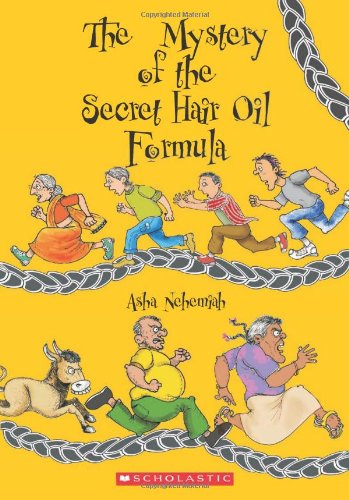
How do we keep readers engaged through a story? How can we figure out how much is too much? Are there any standard formulas to follow?
None of these questions has foolproof answers, but investigating ideas through the structure of a book like The Mystery of the Secret Hair Oil Formula promises to be fulfilling.
Discussing what we find funny is interesting too. While some children thoroughly enjoy silliness and humour, others find it pointless. How can we decide what and how to write?
This book is full of all kinds of crazy, enterprising characters. How do we create vivid characters that stand out?
The point of a workshop is to work together on a piece of writing. Though the scope of this programme is necessarily narrower than that of my writing programme, we will work on small written exercises linked to the book, creating new characters and attempting to flesh them out.
Please do note, however, that the participants will not be given access to the forum to share work and will not be engaging in long written exercises that require detailed feedback and edits.
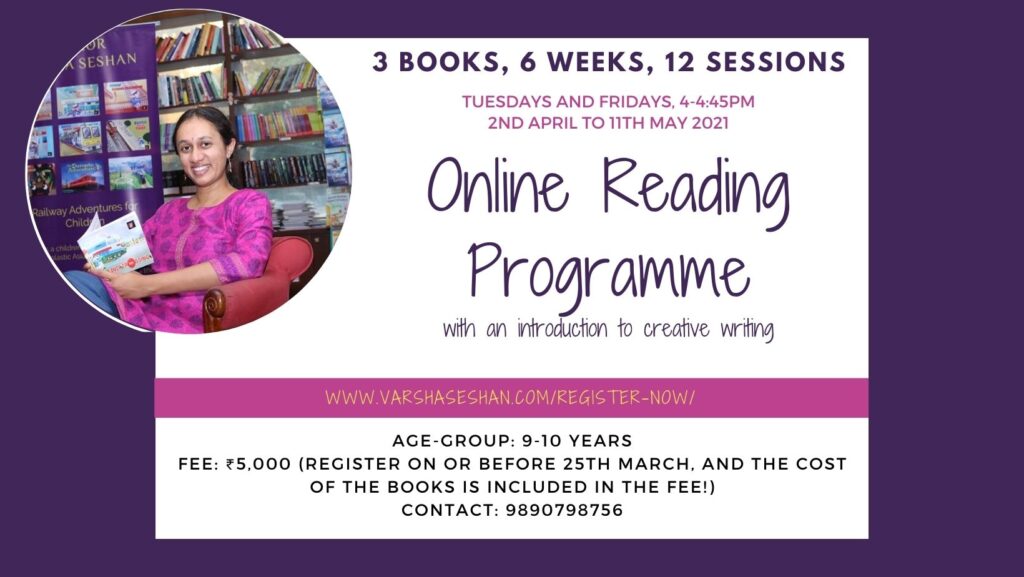
March 1, 2021
It seems to have become something of a tradition to begin each batch of my online reading programme with a hOle book. For the third edition of my programme, it’s going to be Maya in a Mess, a delightful book that made me chuckle. Peopled with sparkling characters, this book is ideal for ages seven and eight, so how could I not include it in my programme?
Maya is the cupboard monitor. The proudest moment of her life is when she is entrusted with the key to the class cupboard. The pride! The honour! The triumph!
I remember the moment oh-so-clearly, and how could I not feel what Maya feels?
Now, you can imagine what the mess is, can’t you?
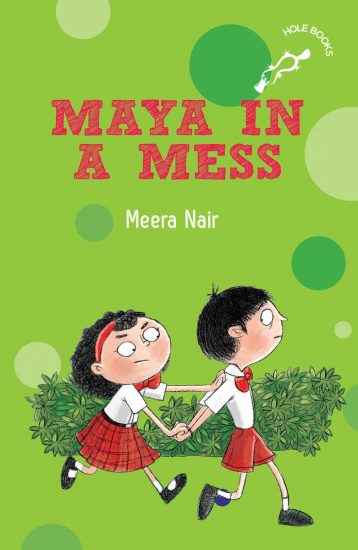
Responsibility is serious business! What was the greatest thing you were entrusted with? What do you do when you make a mistake? How do you think people would react if you lost something precious?
What makes a reading programme different from independent reading? The things we do together!
For Maya in a Mess, I hope to do an activity where the children try to keep something safe. This requires a little work, but there’s so much we can do with the idea! I will ask them to pick up a pebble, paint it and send me a picture. During the very last class at the end of six weeks, I wonder how many of them will be able to show me their pebbles.
Maya in a Mess
Love Like That
Puppies in the Pantry
Timmi in Tangles
What other alliterative phrases would make good book titles?
Playing with sounds is always fun. I hope to make children come up with a book title and create a book cover for their unwritten story.

February 27, 2021
Four books in six weeks – that’s what my current online reading programme involves. And just like that, four weeks have gone by. If I make participants reflect on their journeys with me, I suppose it is because I enjoy the process of reflection myself. Each time I look back, I find myself nodding slowly at some new learning, some new revelation.
Now, at just past the halfway mark, I can’t stop thinking about reading tastes and how much they differ.
“I’m a cheetah reader,” a child said proudly, referring to our second book, Hungry to Read.
“Me too!”
“Me too!”
“I’m a Bull!” said another.
Where I thought children would resent being categorized into ‘cheetah’, ‘bull’ and ‘snail’, they loved the idea!
With Amelia Bedelia, I rediscovered how enjoyable learning can be. I usually dislike linking reading with learning – it’s done too often and puts children (and me!) off.
But with wordplay, when children learn something new, the pleasure they get from reading increases. As we encountered a wild-goose chase, a piece of cake and a pink slip, we explored the madness of words and what they can mean.
“Do you know every single idiom?” a child asked me.
When I shook my head, he asked, “Then how do you know all these?”
Honestly? I don’t know. Probably because I read and love words. The joy of reading with children lies in watching their faces light up as they understand more idioms, make links and discover humour.
In the past four weeks, we’ve made book covers, created recipes and written poems and book reviews. Two weeks to go, and then a break before the next edition begins!
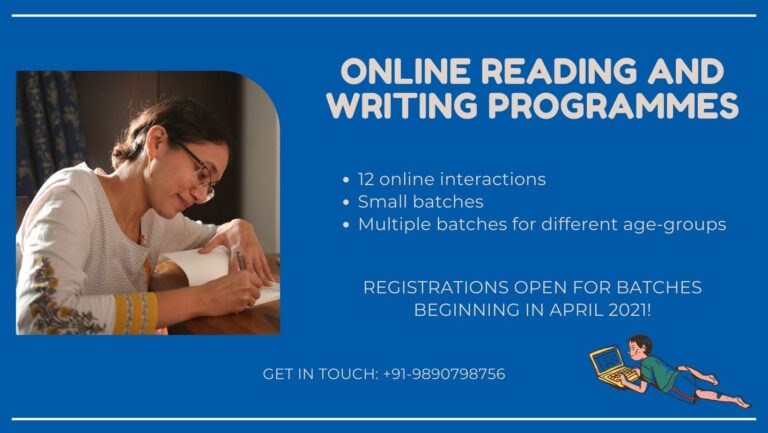
February 9, 2021
REGISTRATIONS ARE NOW CLOSED FOR ALL THESE PROGRAMMES.
The next reading programmes begin in the first week of June, and the next writing programmes will be held in October. I will also organise three short guest sessions as part of my writing programme. These will be free for those who are part of the programme, but will also be open to non-participants on payment of a fee. More details coming soon!
If you would like to receive email notifications about my workshops, please fill this form. Alternatively, follow me on social media – Facebook, Instagram and Twitter – for regular updates.
Many parents with children in the age-group 7-8 expressed interest in my writing programmes, which made me think about what I could do with such young children. For a writing programme to be meaningful, I feel that children need to be a little older. At the same time, the wider the range of books they are exposed to, the better they will write. Among other things, this made me come up with the online reading programme – a book club that involves reading, writing and all kinds of activities.
Starting April 2021, I will also be conducting a similar programme for older children – children in the age-group 9-10.
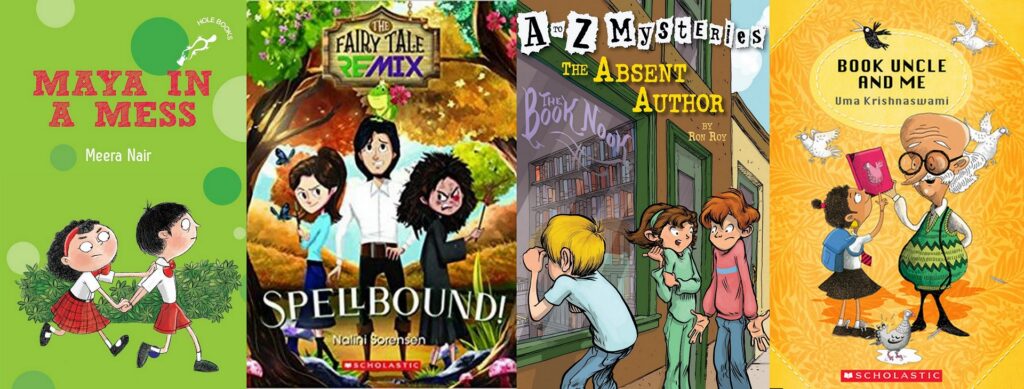
The third edition of my online reading programme for ages 7-8 begins on the 2nd of April 2021. The four books we will read together are Maya in a Mess by Meera Nair, Spellbound by Nalini Sorensen, The Absent Author (A to Z Mysteries Book 1) by Ron Roy and Book Uncle and Me by Uma Krishnaswami.
Dates: 2nd April to 11th May 2021
Online interactions: Tuesdays and Fridays, 3-3:45pm
Age-group: 7-8 years
Workshop fee: ₹4,000
Do note that the cost of the books is no longer included in the fee (UPI: seshanvarsha@okhdfcbank or bank transfer – contact me for details)
REGISTRATIONS ARE NOW CLOSED FOR THIS PROGRAMME.
If you would like to receive email notifications when I launch new batches, please fill this form. Alternatively, follow me on social media – Facebook, Instagram and Twitter – for regular updates.
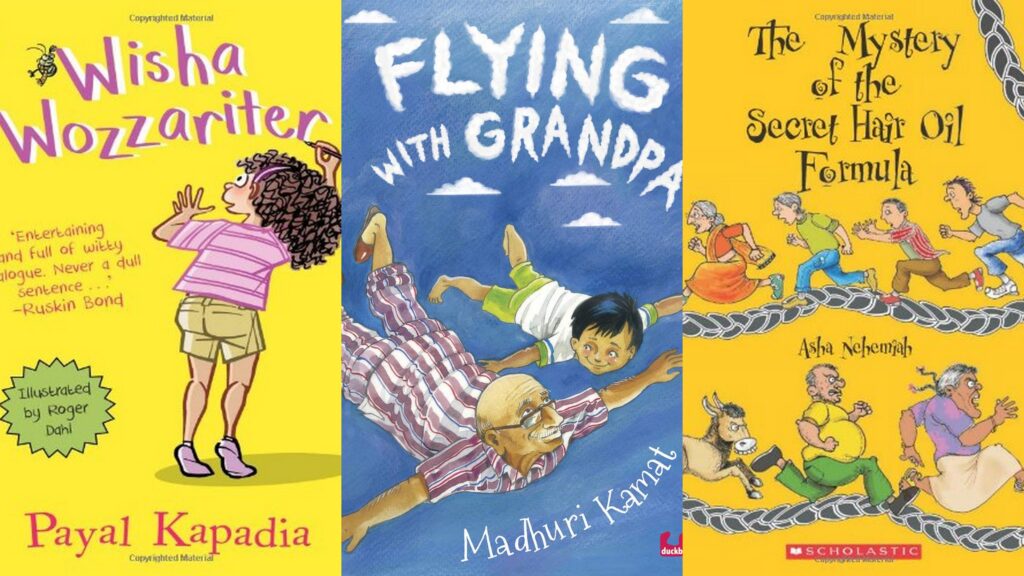
The first edition of my online reading programme for ages 9-10 is here! Just like for the younger ones, the programme is six weeks long and involves 12 video interactions. However, instead of reading four books together, we will read just three. This is because one session every two weeks will be devoted to exercises that introduce creative writing, closely linked to the books we read.
The books we will read during this edition of the online reading programme are The Mystery of the Secret Hair Oil Formula by Asha Nehemiah, Flying with Grandpa by Madhuri Kamat and Wisha Wozzariter by Payal Kapadia.
Dates: 2nd April to 11th May 2021
Online interactions: Tuesdays and Fridays, 4-4:45pm
Age-group: 9-10 years
Workshop fee: ₹5,000
Do note that the cost of the books is no longer included in the fee (UPI: seshanvarsha@okhdfcbank or bank transfer – contact me for details)
REGISTRATIONS ARE NOW CLOSED FOR THIS PROGRAMME.
If you would like to receive email notifications when I launch new batches, please fill this form. Alternatively, follow me on social media – Facebook, Instagram and Twitter – for regular updates.
My online creative writing programmes are conducted just twice a year – in April and in October. Each course is 12 weeks long and comprises twelve online interactions and access to a private, secure forum, where participants share work and provide feedback to one another. In this sense, it is an intensive programme that requires participants to log in at least four times a week, write regularly and participate actively on the forum. In addition to weekly assignments, participants are encouraged to share relevant ideas and opinions at each stage.
If I have a minimum of four participants for each batch, I also organize guest sessions, which are open to non-participants on payment of a registration fee, but free for those who are part of my programmes. Take a look at the three guest sessions I organized during the previous edition of the creative writing programme:
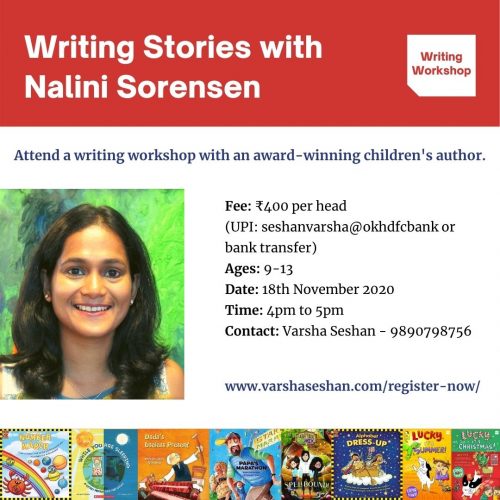
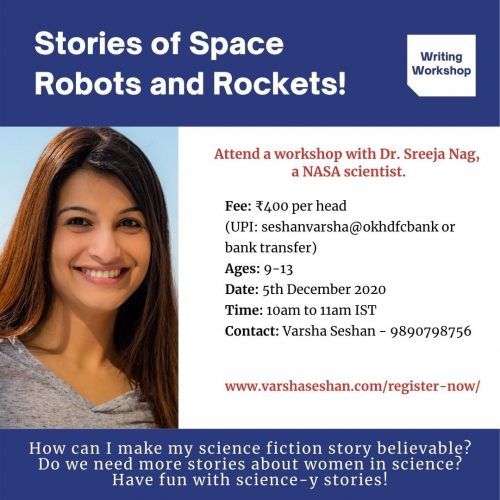
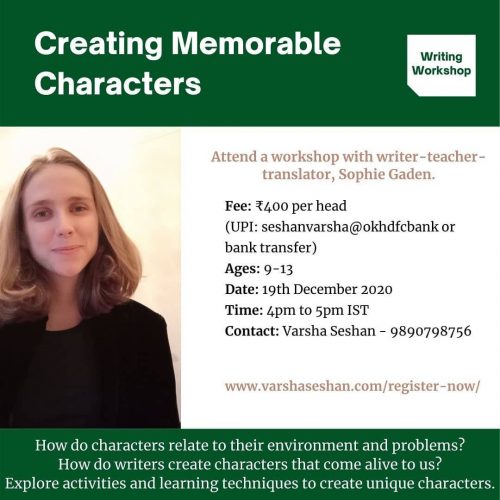
The next course for the age-group 9-11 begins on the 5th of April. The online interactions will be held each Monday from 4pm to 5pm.
Dates: 5th April to 28th June 2021
Online interactions: Mondays, 4-5pm
Age-group: 9-11 years
Workshop fee:
REGISTRATIONS ARE NOW CLOSED FOR THIS PROGRAMME.
If you would like to receive email notifications when I launch new batches, please fill this form. Alternatively, follow me on social media – Facebook, Instagram and Twitter – for regular updates.
I launched my online creative writing programme in October 2020 and received a wonderful response. Take a look at what some of the children said when they reflected on the programme!
The next course for the age-group 12-14 begins on the 7th of April. The online interactions will be held each Wednesday from 4pm to 5pm.
Dates: 7th April to 30th June 2021
Online interactions: Wednesdays, 4-5pm
Age-group: 12-14 years
Workshop fee:
REGISTRATIONS ARE NOW CLOSED FOR THIS PROGRAMME.
If you would like to receive email notifications when I launch new batches, please fill this form. Alternatively, follow me on social media – Facebook, Instagram and Twitter – for regular updates.
I’ve been conducting writers’ clubs since 2015, so exploring the Workshops page would give you a gist of the activities I conduct. During the previous edition of the online creative writing programme, a few participants reflected on their journeys as writers. Take a look.
Additionally, here are a few posts that will give you a rough idea of how my creative writing workshops work:
January 25, 2021
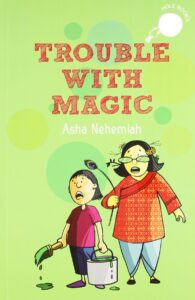
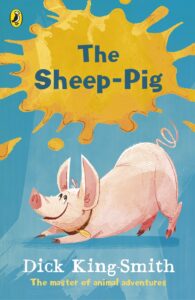
Magic potions.
Superpowers. Word games.
Adjectives, homophones, homonyms, mazes.
Codes, recitation, performance.
What fun my first reading programme was!
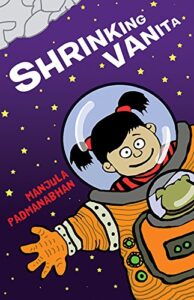
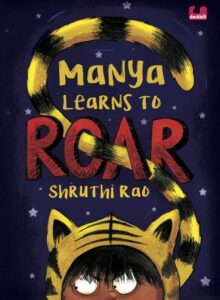
The first book we read together was Trouble with Magic by Asha Nehemiah. A reading programme involves more than simply reading the book, though, so we used our imaginations. What would we get if we put different ingredients together? A medicine? A magic potion? An explosion?
Each of the children came up with something different, and it was such fun! Take a look at just one of them.
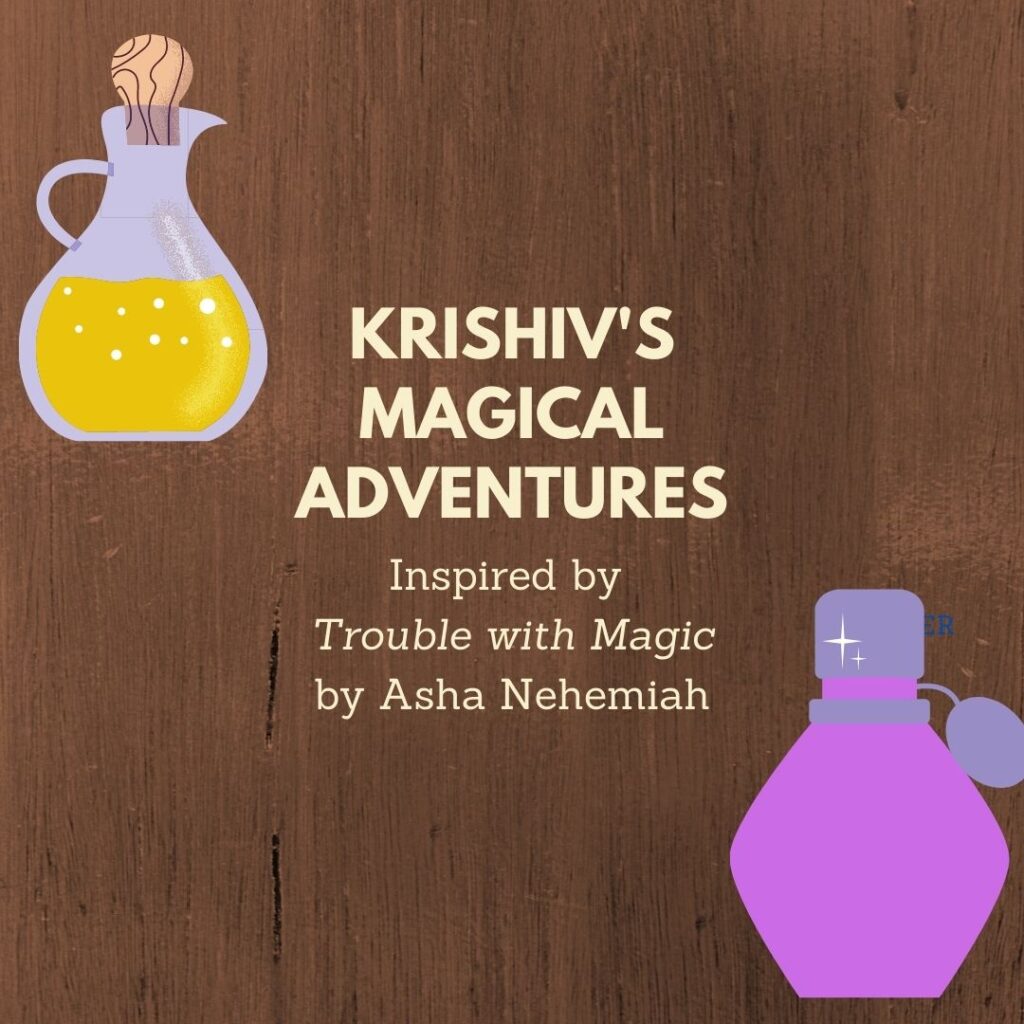
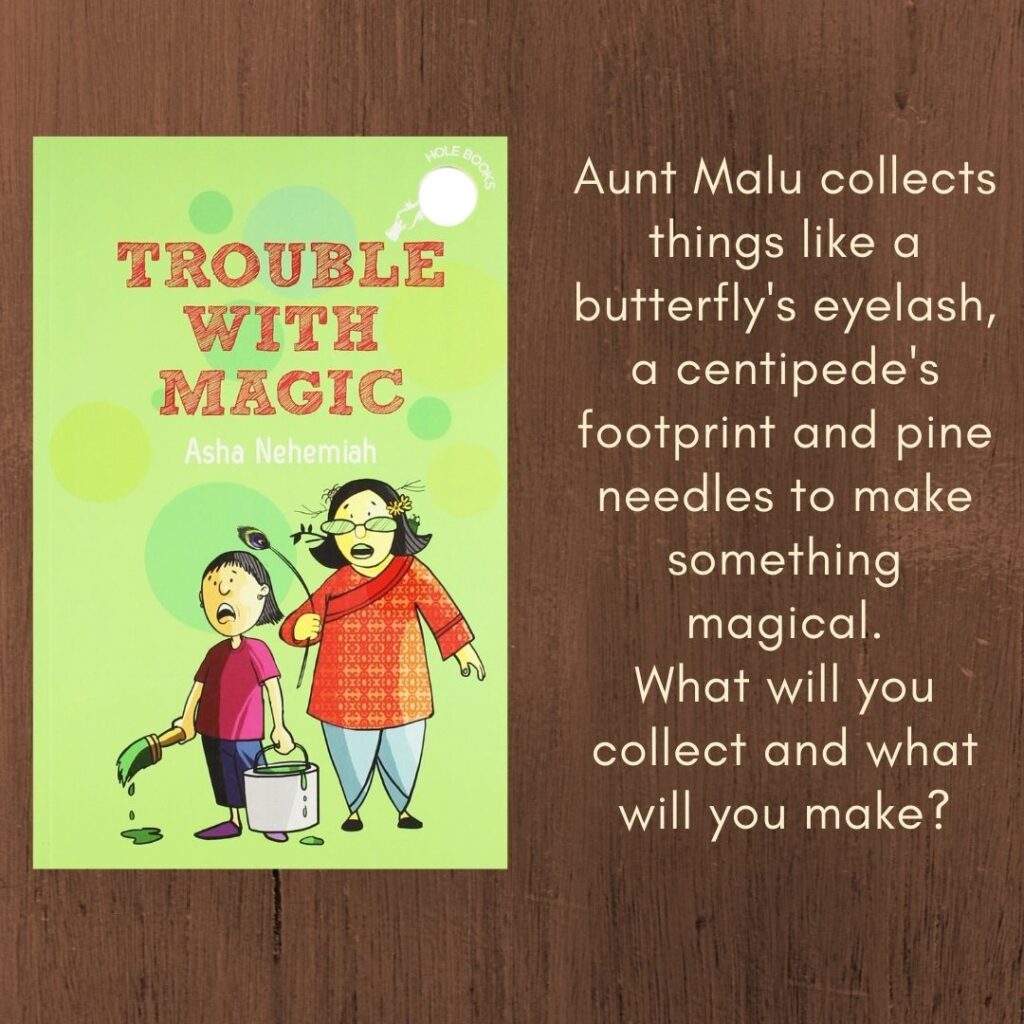
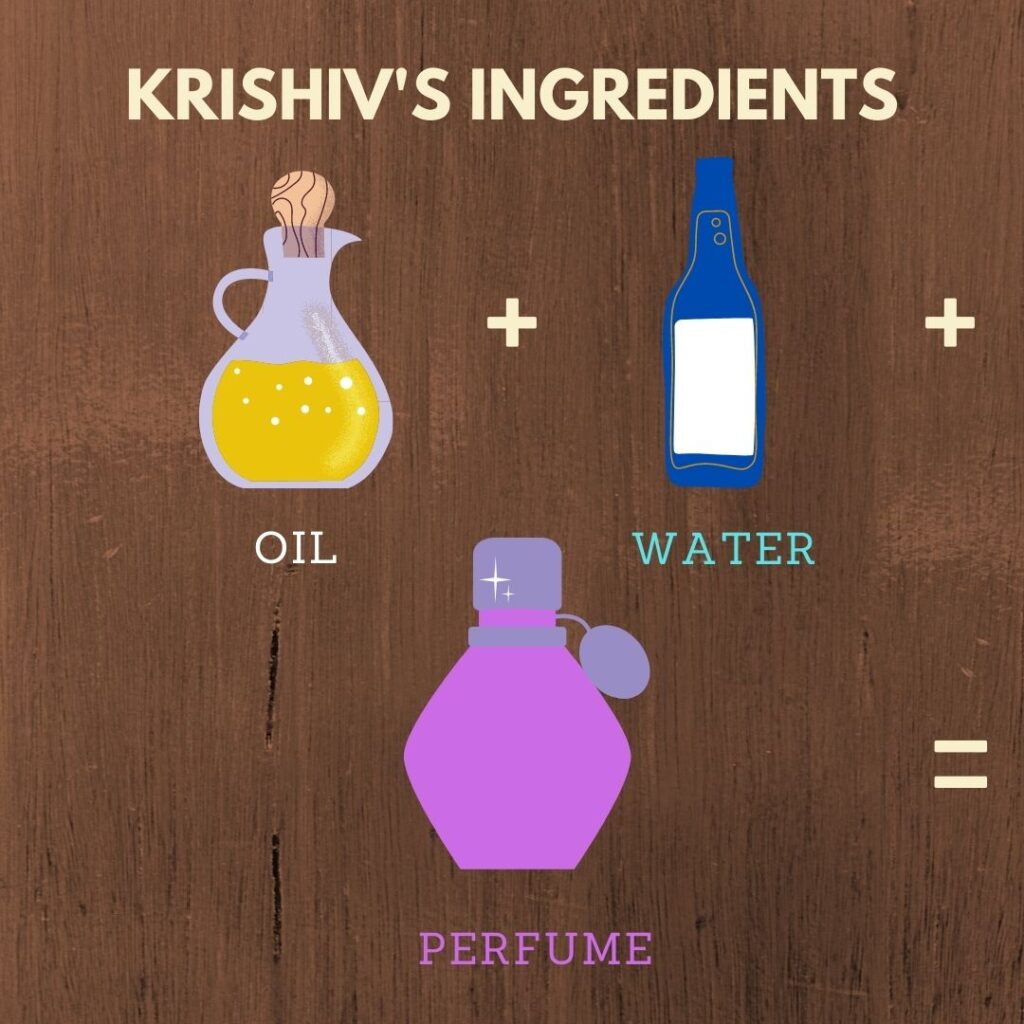
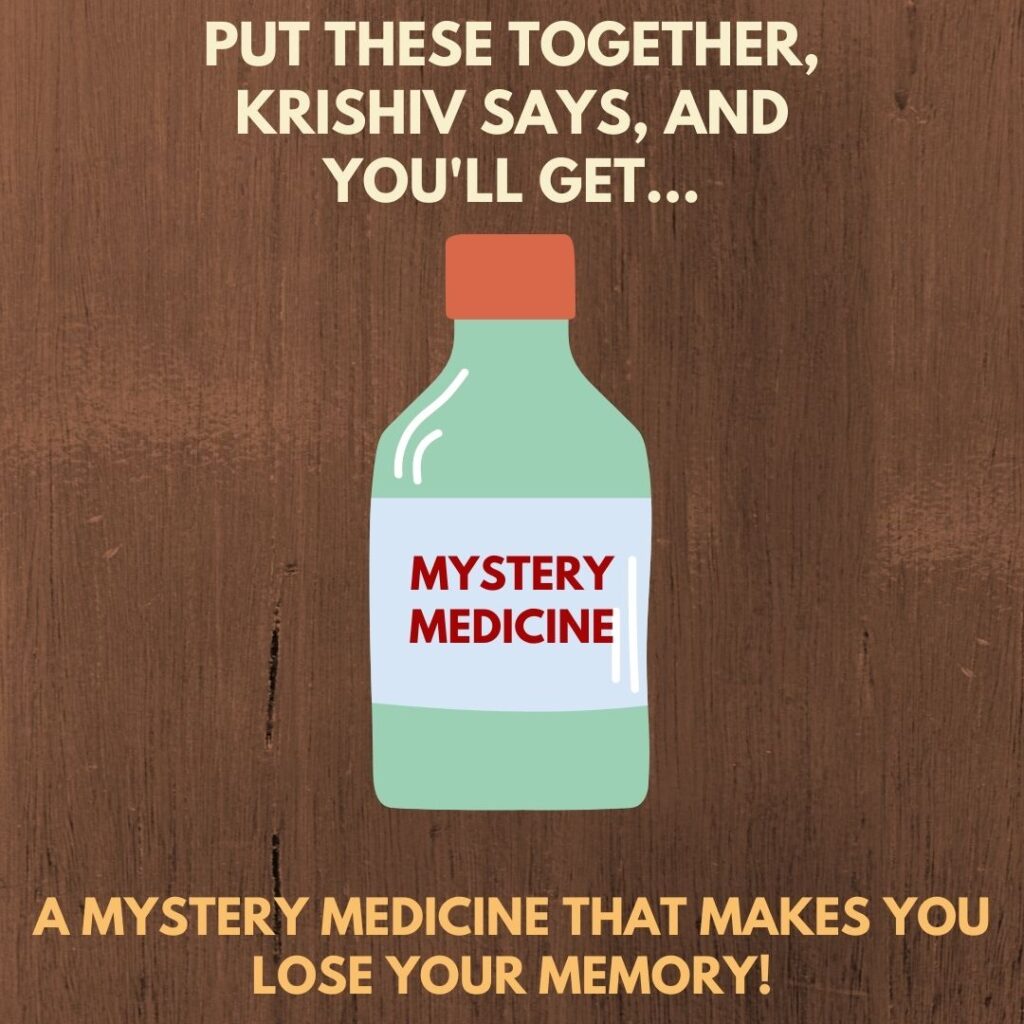
Our second book was Shrinking Vanita by Manjula Padmanabhan. Apart from word games, where we attempted to unscramble words from the book, we created our own superheroes. What if everyone suddenly shrinks to half their size? What superpower would you need to save the world?
And on the other hand, what if you could stretch your body infinitely? What special things could you do to help other people?
Our third book was The Sheep-Pig by Dick King-Smith, a childhood favourite. Babe the sheep-pig has to follow a specific set of instructions in order to win the sheep-dog trials. Reading and following instructions, the children followed a path too, determining how a dog would herd the sheep to their pen.
We also worked with adjectives. How would you describe Babe? What characteristics come to mind when you think of the sheep-pig?
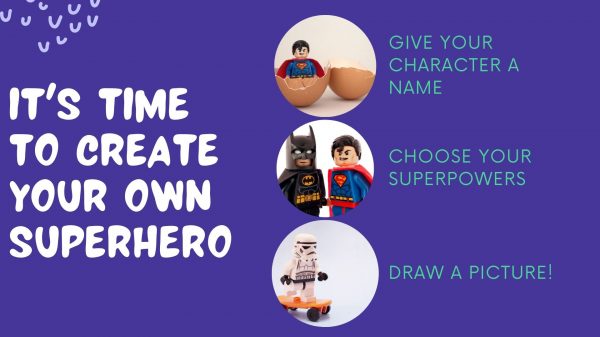
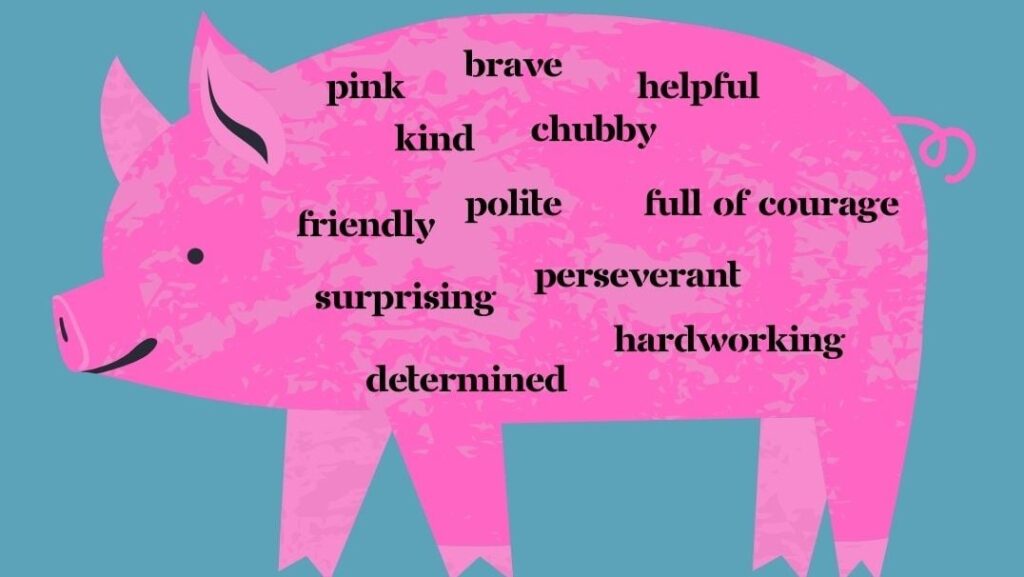
The last book we worked with was Manya Learns to Roar. This was the book where we had the most interaction, as children deciphered the code at the beginning of each chapter. They wrote their names in code and figured out the notes inside the book. We had such fun!
Instead of a ‘come as a character’ activity, I had each of them recite a poem. One child did such a lovely, dramatic recitation of ‘I opened a book’ by Julia Donaldson. I loved another child’s performance too, but I cannot remember much of the poem except that it was a lot like ‘Sick’ by Shel Silverstein.
And that’s the end of my first reading programme; watch out for the next one!
January 23, 2021
Amelia Bedelia. The name just asks you to read it aloud. And what a character Amelia is! As with the very best fictional characters (I’m thinking of Anne Shirley, Pippi Longstocking and the like), Amelia’s personality leaps out of the pages. She makes you chuckle at her sheer optimism, at her zest and her drive. Obstacles? What are those?
Amelia sees Suzanne’s new bike and knows she has to get one for herself. But her parents are unwilling to give her an advance Christmas-cum-birthday present. What they are willing to do, however, is meet her halfway. If she can find a way to pay half the price, they’ll pay the other half. Amelia and her father shake hands, and they have a deal.
The problem, though, is Amelia’s tendency to take things literally. Idioms are puzzling. Ways of speaking make no sense. So, when she’s working at a restaurant and a customer asks her for ‘a pie – and step on it’, what do you think she does?
I know that Amelia Bedelia Means Business is probably a little advanced for some children in this age group, but it’s so much fun that I’m sure we’ll enjoy it anyway! Here’s what I will do with it at my reading programme.

I’ve done workshops on idioms before, but I now know that Amelia Bedelia Means Business is the perfect book to use even in the future to play with idioms. What do we mean by the following?
I’m sure discussing these will lead to hilarious exchanges!
Children always have wonderful business ideas. How can they earn money? What would they do with money that they earn? Do they have a piggy bank? I think we can have so many intriguing conversations about money making!
What do we do when we make a mistake? How frightening is failure? Amelia is one resilient character. She makes mistake after mistake and bounces back each time. A book like this creates a safe space for children to talk about their failures and mistakes, and what they did to move on.
Registrations are now closed for this reading programme. Find out about the next one here.
If you would like to receive email notifications when I launch new batches, please fill this form. Alternatively, follow me on social media – Facebook, Instagram and Twitter – for regular updates.
January 19, 2021
If there was one thing that could push you to read, what would that be? How would you get someone who doesn’t like reading to read?
When Arjun’s teacher announces a competition in school, Arjun is thrilled – until he learns that it is a reading competition. He is no reader; he likes logic, facts and all things mathematical. The problem is that the prize is so attractive that Arjun is tempted. The question, though, is how far he is willing to go to help his class to win.
The reasons I chose Hungry to Read for my reading programme are very different from the reasons I chose every other book. More than having enjoyed the book, I love the possibilities it has when it comes to activities and conversations. Here is some of what I will do with the book.

I love book scavenger hunts! We’ll do a quick one with this book, simply to start a conversation on the different kinds of books we read.
Some conversations need to happen time and time again if ever we want to move away from ideas of ‘girlie’ and ‘bad English’. Why does Arjun find a book about a princess too girlie? Why does Sheen get angry with Rio’s lack of fluency?
Language shaming is something I’ve written about in the past, and it finds its worst form when it comes to a language like English. Language shaming leaves deep impressions on children, and this is something I want children to think about. Gender stereotyping is something I have trouble with in books too, and I want conversations to happen around what constitutes ‘girlie’ and what is ‘boyish’. How much will seven- and eight-year-olds contribute to a conversation like this? I can only begin the conversation and find out!
A book about a Read Drive is a wonderful way to introduce children to how to choose books. During the reading challenges at the British Library, I often found children picking the thinnest possible books so that they could easily get done with their quota of six books in six weeks. Other children, seeking to impress their teachers, chose the thickest book, paying no attention to whether it seemed interesting to them.
How do we choose a book? How can we pick something suited to our age, understanding and interest? I will use Hungry to Read to talk about it!
Registrations are now closed for this reading programme. If you would like to receive email notifications when I launch new batches, please fill this form. Alternatively, follow me on social media – Facebook, Instagram and Twitter – for regular updates.
